 | –≠–ª–µ–∫—Ç—Ä–æ–Ω–Ω—ã–π –∫–æ–º–ø–æ–Ω–µ–Ω—Ç: SAA7127 | –°–∫–∞—á–∞—Ç—å:  PDF PDF  ZIP ZIP |

DATA SHEET
Product specification
File under Integrated Circuits, IC22
1999 May 31
INTEGRATED CIRCUITS
SAA7126H; SAA7127H
Digital video encoder

1999 May 31
2
Philips Semiconductors
Product specification
Digital video encoder
SAA7126H; SAA7127H
FEATURES
∑
Monolithic CMOS 3.3 V device, 5 V I
2
C-bus optionally
∑
Digital PAL/NTSC encoder
∑
System pixel frequency 13.5 MHz
∑
54 MHz double-speed multiplexed D1 interface capable
of splitting data into two separate channels (encoded
and baseband)
∑
Four Digital-to-Analog Converters (DACs) for CVBS
(CSYNC, VBS), RED (Cr, C), GREEN (Y, VBS) and
BLUE (Cb, CVBS) two times oversampled (signals in
parenthesis are optionally). RED (Cr), GREEN (Y) and
BLUE (Cb) signal outputs with 9-bit resolution, whereas
all other signal outputs have 10-bit resolution; CSYNC is
an advanced composite sync on the CVBS output for
RGB display centring.
∑
Real-time control of subcarrier
∑
Cross-colour reduction filter
∑
Closed captioning encoding and World Standard
Teletext (WST) and North-American Broadcast Text
System (NABTS) teletext encoding including sequencer
and filter
∑
Copy Generation Management System (CGMS)
encoding (CGMS described by standard CPR-1204 of
EIAJ); 20 bits in lines 20/283 (NTSC) can be loaded via
the I
2
C-bus
∑
Fast I
2
C-bus control port (400 kHz)
∑
Line 23 Wide Screen Signalling (WSS) encoding
∑
Video Programming System (VPS) data encoding in
line 16 (CCIR line count)
∑
Encoder can be master or slave
∑
Programmable horizontal and vertical input
synchronization phase
∑
Programmable horizontal sync output phase
∑
Internal Colour Bar Generator (CBG)
∑
Macrovision Pay-per-View copy protection system
rev. 7.01 and rev. 6.1 as option; `handsfree' Macrovision
pulse support through on-chip timer for pulse amplitude
modulation; this applies to SAA7126H only. The device
is protected by USA patent numbers 4631603, 4577216
and 4819098 and other intellectual property rights.
Use of the Macrovision anti-copy process in the device
is licensed for non-commercial home use only. Reverse
engineering or disassembly is prohibited. Please
contact your nearest Philips Semiconductors sales
office for more information.
∑
Controlled rise/fall times of output syncs and blanking
∑
On-chip crystal oscillator (3rd-harmonic or fundamental
crystal)
∑
Down mode (low output voltage) or power-save mode of
DACs
∑
QFP44 package.
GENERAL DESCRIPTION
The SAA7126H; SAA7127H encodes digital Cb-Y-Cr
video data to an NTSC or PAL CVBS or S-video signal.
Simultaneously, RGB or bypassed but interpolated
Cb-Y-Cr signals are available via three additional
Digital-to-Analog Converters (DACs). The circuit at a
54 MHz multiplexed digital D1 input port accepts two CCIR
compatible Cb-Y-Cr data streams with 720 active pixels
per line in 4 : 2 : 2 multiplexed formats, for example MPEG
decoded data with overlay and MPEG decoded data
without overlay, whereas one data stream is latched at the
rising, the other one at the falling clock edge.
It includes a sync/clock generator and on-chip DACs.
ORDERING INFORMATION
TYPE NUMBER
PACKAGE
NAME
DESCRIPTION
VERSION
SAA7126H
QFP44
plastic quad flat package; 44 leads (lead length 1.3 mm);
body 10
◊
10
◊
1.75 mm
SOT307-2
SAA7127H

1999 May 31
3
Philips Semiconductors
Product specification
Digital video encoder
SAA7126H; SAA7127H
QUICK REFERENCE DATA
BLOCK DIAGRAM
SYMBOL
PARAMETER
MIN.
TYP.
MAX.
UNIT
V
DDA
analog supply voltage
3.15
3.3
3.45
V
V
DDD
digital supply voltage
3.0
3.3
3.6
V
I
DDA
analog supply current
-
77
100
mA
I
DDD
digital supply current
-
37
46
mA
V
i
input signal voltage levels
TTL compatible
V
o(p-p)
analog output signal voltages Y, C and CVBS
without load (peak-to-peak value)
1.30
1.45
1.55
V
R
L
load resistance
75
-
300
LE
lf(i)
low frequency integral linearity error
-
-
±
3
LSB
LE
lf(d)
low frequency differential linearity error
-
-
±
1
LSB
T
amb
ambient temperature
0
-
70
∞
C
Fig.1 Block diagram.
handbook, full pagewidth
I
2
C-BUS
INTERFACE
DATA
MANAGER
ENCODER
SYNC/CLOCK
OUTPUT
INTERFACE
D
A
40
42
41
7
8
43
37
34
35
4
MP7
to
MP0
TTX
VDD(I2C)
19
30
23
26
RESET SDA SCL
RCV1
RCV2
TTXRQ
XCLK
XTAL
XTALI
LLC1
CVBS
RED
GREEN
29
BLUE
I
2
C-bus
control
I
2
C-bus
control
I
2
C-bus
control
I
2
C-bus
control
I
2
C-bus
control
5
VSSD1
18
VSSD2
38
VSSD3
6
VDDD1
17
VDDD2
39
VDDD3
22
VSSA1
32
VSSA2
33
VSSA3
25
VDDA1
28
VDDA2
31
VDDA3
36
VDDA4
RTCI
2
3
SP
AP
clock
and timing
Y
Y
C
RGB
PROCESSOR
I
2
C-bus
control
Y
CbCr
CbCr
44
20
SA
21
RES
1
n.c.
24, 27
9 to 16
MP1
MP2
MHB498
SAA7126H
SAA7127H
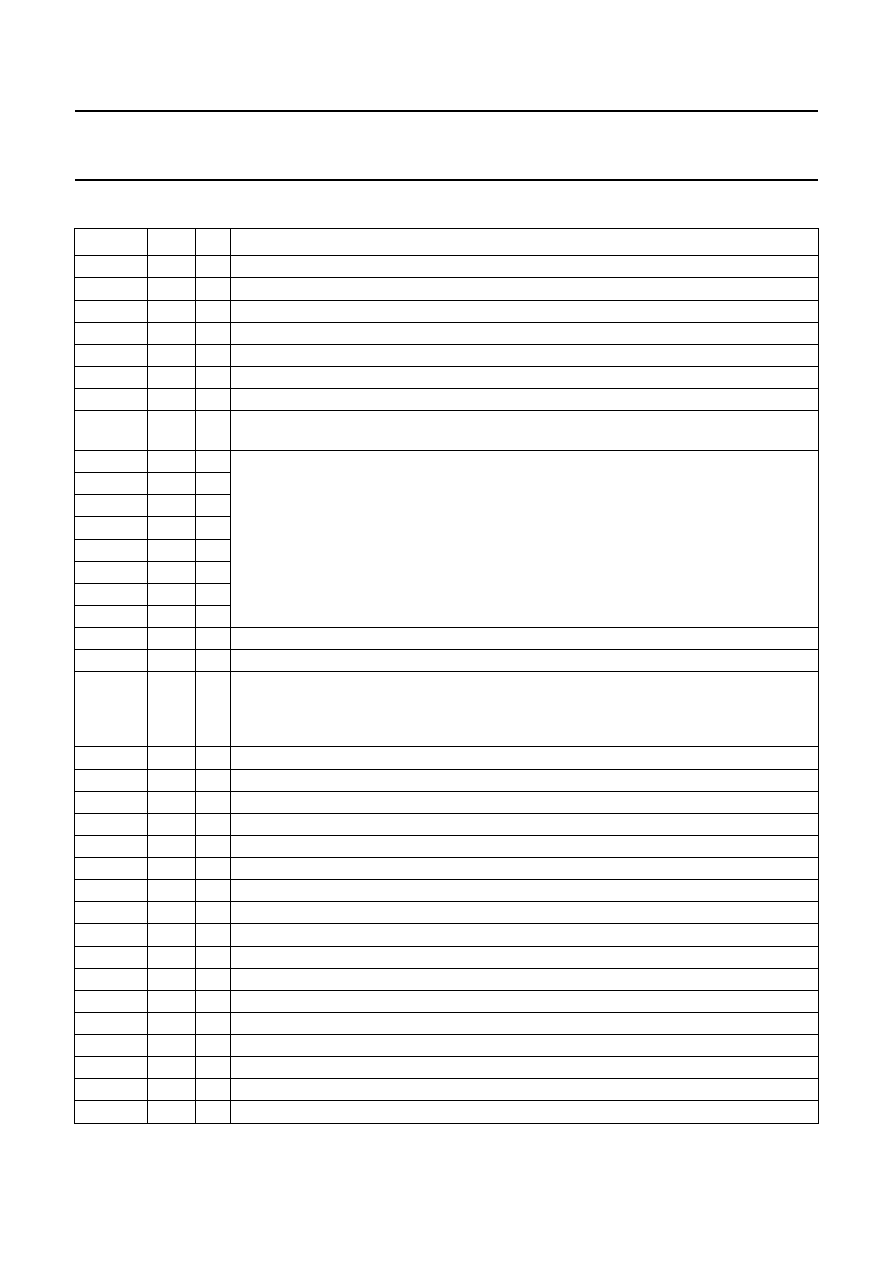
1999 May 31
4
Philips Semiconductors
Product specification
Digital video encoder
SAA7126H; SAA7127H
PINNING
SYMBOL TYPE PIN
DESCRIPTION
RES
-
1
reserved pin; do not connect
SP
I
2
test pin; connected to digital ground for normal operation
AP
I
3
test pin; connected to digital ground for normal operation
LLC1
I
4
line-locked clock input; this is the 27 MHz master clock
V
SSD1
-
5
digital ground 1
V
DDD1
-
6
digital supply voltage 1
RCV1
I/O
7
raster control 1 for video port; this pin receives/provides a VS/FS/FSEQ signal
RCV2
I/O
8
raster control 2 for video port; this pin provides an HS pulse of programmable length or
receives an HS pulse
MP7
I
9
double-speed 54 MHz MPEG port; it is an input for
"CCIR 656" style multiplexed Cb-Y-Cr
data; data is sampled on the rising and falling clock edge; data sampled on the rising edge is
then sent to the encoding part of the device; data sampled on the falling edge is sent to the
RGB part of the device (or vice versa, depending on programming)
MP6
I
10
MP5
I
11
MP4
I
12
MP3
I
13
MP2
I
14
MP1
I
15
MP0
I
16
V
DDD2
-
17
digital supply voltage 2
V
SSD2
-
18
digital ground 2
RTCI
I
19
real-time control input (I
2
C-bus register SRES = 0): if the LLC1 clock is provided by an
SAA7111 or SAA7151B, RTCI should be connected to the RTCO pin of the respective
decoder to improve the signal quality. Sync reset input (I
2
C-bus register SRES = 1): a HIGH
impulse resets synchronization of the encoder (first field, first line).
V
DD(I2C)
-
20
sense input for I
2
C-bus voltage; connect to I
2
C-bus supply
SA
I
21
select I
2
C-bus address; LOW selects slave address 88H, HIGH selects slave address 8CH
V
SSA1
-
22
analog ground 1 for RED (Cr) (C) and GREEN (Y) (VBS) outputs
RED
O
23
analog output of RED (Cr) or (C) signal
n.c.
-
24
not connected
V
DDA1
-
25
analog supply voltage 1 for RED (Cr) (C) output
GREEN
O
26
analog output of GREEN (Y) or (VBS) signal
n.c.
-
27
not connected
V
DDA2
-
28
analog supply voltage 2 for GREEN (Y) (VBS) output
BLUE
O
29
analog output of BLUE (Cb) or (CVBS) signal
CVBS
O
30
analog output of CVBS (CSYNC) or (VBS) signal
V
DDA3
-
31
analog supply voltage 3 for BLUE (Cb) (CVBS) and CVBS (CSYNC) (VBS) outputs
V
SSA2
-
32
analog ground 2 for BLUE (Cb) (CVBS) and CVBS (CSYNC) (VBS) outputs
V
SSA3
-
33
analog ground 3 for the DAC reference ladder and the oscillator
XTAL
O
34
crystal oscillator output
XTALI
I
35
crystal oscillator input; if the oscillator is not used, this pin should be connected to ground
V
DDA4
-
36
analog supply voltage 4 for the DAC reference ladder and the oscillator
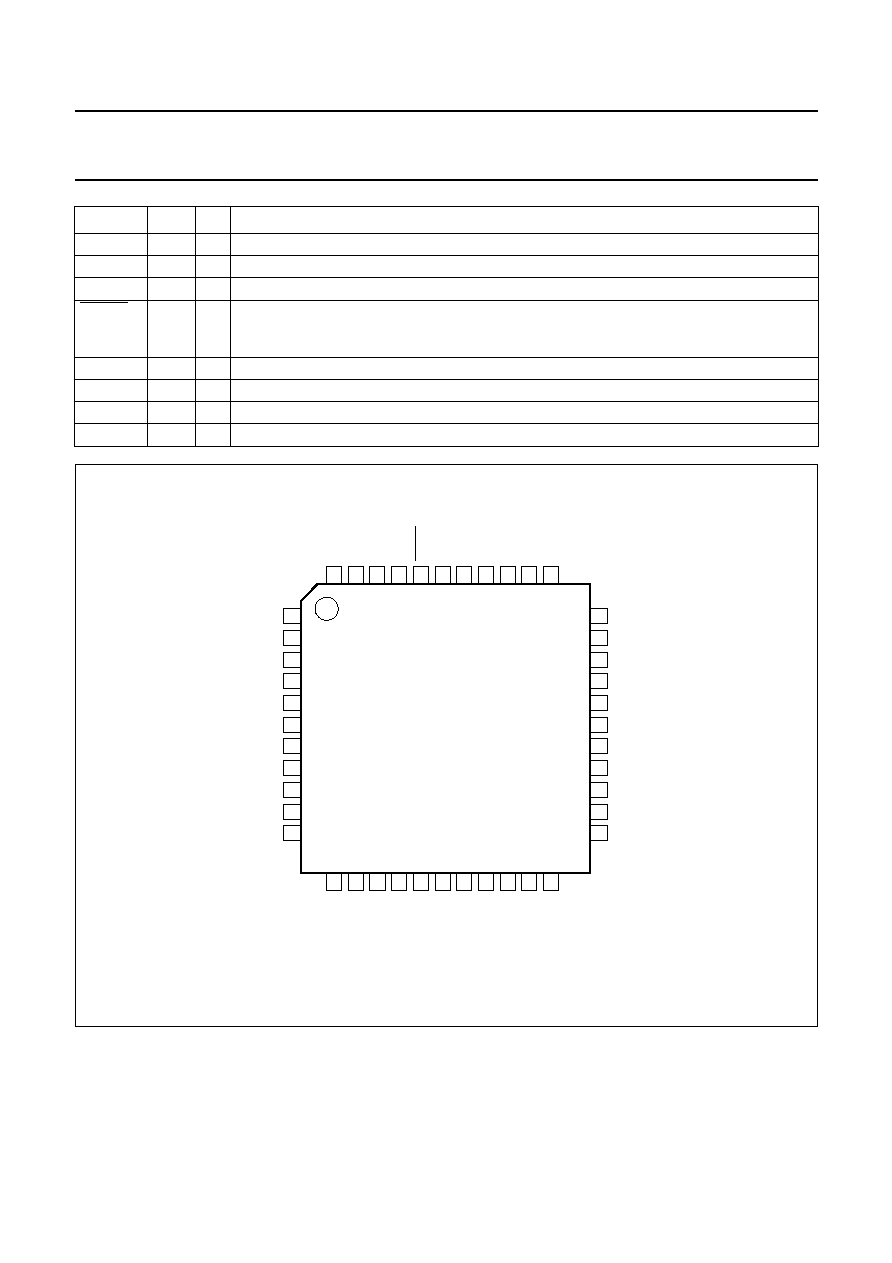
1999 May 31
5
Philips Semiconductors
Product specification
Digital video encoder
SAA7126H; SAA7127H
XCLK
O
37
clock output of the crystal oscillator
V
SSD3
-
38
digital ground 3
V
DDD3
-
39
digital supply voltage 3
RESET
I
40
reset input, active LOW. After reset is applied, all digital I/Os are in input mode; PAL black
burst on CVBS, VBS and C; RGB outputs set to lowest voltage. The I
2
C-bus receiver waits
for the START condition.
SCL
I
41
I
2
C-bus serial clock input
SDA
I/O
42
I
2
C-bus serial data input/output
TTXRQ
O
43
teletext request output, indicating when text bits are requested
TTX
I
44
teletext bit stream input
SYMBOL TYPE PIN
DESCRIPTION
Fig.2 Pin configuration.
handbook, full pagewidth
1
2
3
4
5
6
7
8
9
10
11
33
32
31
30
29
28
27
26
25
24
23
12
13
14
15
16
17
18
19
20
21
22
44
43
42
41
40
39
38
37
36
35
34
SAA7126H
SAA7127H
MHB499
VSSA3
VSSA2
VDDA3
CVBS
VDDA2
n.c.
GREEN
VDDA1
n.c.
RED
RES
SP
AP
LLC1
VSSD1
VDDD1
RCV2
MP7
MP5
BLUE
TTXRQ
SDA
SCL
RESET
V
DDD3
V
SSD3
V
DDA4
XTALI
XTAL
TTX
XCLK
MP3
MP2
MP1
MP0
V
DDD2
V
SSD2
V
DD(I2C)
SA
V
SSA1
MP4
RTCI
RCV1
MP6

1999 May 31
6
Philips Semiconductors
Product specification
Digital video encoder
SAA7126H; SAA7127H
FUNCTIONAL DESCRIPTION
The digital video encoder encodes digital luminance and
colour difference signals into analog CVBS, S-video and
simultaneously RGB or Cr-Y-Cb signals. NTSC-M, PAL
B/G and sub-standards are supported.
Both interlaced and non-interlaced operation is possible
for all standards.
The basic encoder function consists of subcarrier
generation, colour modulation and insertion of
synchronization signals. Luminance and chrominance
signals are filtered in accordance with the standard
requirements of
"RS-170-A" and "ITU-R BT.470-3".
For ease of analog post filtering the signals are twice
oversampled with respect to the pixel clock before
digital-to-analog conversion.
The total filter transfer characteristics are illustrated in
Figs 3 to 8. The DACs for Y, C and CVBS are realized with
full 10-bit resolution; 9-bit resolution for RGB output.
The Cr-Y-Cb to RGB dematrix can be bypassed optionally
in order to provide the upsampled Cr-Y-Cb input signals.
The 8-bit multiplexed Cb-Y-Cr formats are
"CCIR 656"
(D1 format) compatible, but the SAV and EAV codes can
be decoded optionally; when the device is operated in
slave mode. Two independent data streams can be
processed, one latched by the rising edge of LLC1, the
other latched by the falling edge of LLC1. The purpose of
that is e.g. to forward one of the data streams containing
both video and On Screen Display (OSD) information to
the RGB outputs, and the other stream containing video
only to the encoded outputs CVBS and S-video.
For optimum display of RGB signals through a
euro-connector TV set, an early composite sync pulse (up
to 31LLC1 clock periods) can be provided optionally on the
CVBS output.
It is also possible to connect a Philips digital video decoder
(SAA7111, SAA7711A, SAA7112 or SAA7151B) to the
SAA7126H; SAA7127H. Information concerning the actual
subcarrier, PAL-ID and (with SAA7111 and newer types)
definite subcarrier phase can be inserted via the RTCI pin,
connected to the RTCO pin of a decoder.
The SAA7126H; SAA7127H synthesizes all necessary
internal signals, colour subcarrier frequency and
synchronization signals from that clock.
Wide screen signalling data can be loaded via the I
2
C-bus
and is inserted into line 23 for standards using a 50 Hz
field rate.
VPS data for program dependent automatic start and stop
of such featured VCR's is loadable via the I
2
C-bus.
The IC also contains closed caption and extended data
services encoding (line 21), and supports anti-taping
signal generation in accordance with Macrovision. It is also
possible to load data for copy generation management
system into line 20 of every field (525/60 line counting).
A number of possibilities are provided for setting different
video parameters such as:
∑
Black and blanking level control
∑
Colour subcarrier frequency
∑
Variable burst amplitude etc.
During reset (RESET = LOW) and after reset is released,
all digital I/O stages are set to the input mode and the
encoder is set to PAL mode and outputs a `black burst'
signal on CVBS and S-video outputs, while RGB outputs
are set to their lowest output voltages. A reset forces the
I
2
C-bus interface to abort any running bus transfer.
Data manager
In the data manager, alternatively to the external video
data, a pre-defined colour look-up table located in this
block can be read out in a pre-defined sequence (8 steps
per active video line), achieving a colour bar test pattern
generator without need for an external data source.
Encoder
V
IDEO PATH
The encoder generates out of Y, U and V baseband
signals luminance and colour subcarrier output signals,
suitable for use as CVBS or separate Y and C signals.
Luminance is modified in gain and in offset (latter
programmable in a certain range to enable different black
level set-ups). After insertion of a fixed synchronization
pulse tip level, in accordance with standard composite
synchronization schemes, a blanking level can be set.
Other manipulations used for the Macrovision anti-taping
process such as additional insertion of AGC super-white
pulses (programmable in height) are supported by
SAA7126H only.
In order to enable easy analog post filtering, luminance is
interpolated from 13.5 MHz data rate to 27 MHz data rate,
providing luminance in 10-bit resolution. The transfer
characteristic of the luminance interpolation filter are
illustrated in Figs 5 and 6. Appropriate transients at
start/end of active video and for synchronization pulses
are ensured.

1999 May 31
7
Philips Semiconductors
Product specification
Digital video encoder
SAA7126H; SAA7127H
Chrominance is modified in gain (programmable
separately for U and V), standard dependent burst is
inserted, before baseband colour signals are interpolated
from a 6.75 MHz data rate to a 27 MHz data rate. One of
the interpolation stages can be bypassed, thus providing a
higher colour bandwidth, which can be made use of for
Y and C output. The transfer characteristics of the
chrominance interpolation filter are illustrated in
Figs 3 and 4.
The amplitude, beginning and ending of the inserted burst,
is programmable in a certain range that is suitable for
standard signals and for special effects. Behind the
succeeding quadrature modulator, colour in 10-bit
resolution is provided on the subcarrier.
The numeric ratio between the Y and C outputs is in
accordance with set standards.
T
ELETEXT INSERTION AND ENCODING
Pin TTX receives a WST or NABTS teletext bitstream
sampled at the LLC clock. Two protocols are provided: at
each rising edge of output signal (TTXRQ) a single teletext
bit has to be provided after a programmable delay at input
pin TTX. Or: the signal TTXRQ performs only a single
LOW-to-HIGH transition and remains at HIGH level for
360, 296 or 288 teletext bits, depending on the chosen
standard.
Phase variant interpolation is achieved on this bitstream in
the internal teletext encoder, providing sufficient small
phase jitter on the output text lines.
TTXRQ provides a fully programmable request signal to
the teletext source, indicating the insertion period of
bitstream at lines which are selectable independently for
both fields. The internal insertion window for text is set
to 360 (PAL-WST), 296 (NTSC-WST) or 288 (NABTS)
teletext bits including clock run-in bits. The protocol and
timing are illustrated in Fig.14.
V
IDEO
P
ROGRAMMING
S
YSTEM
(VPS)
ENCODING
Five bytes of VPS information can be loaded via the
I
2
C-bus and will be encoded in the appropriate format into
line 16.
C
LOSED CAPTION ENCODER
Using this circuit, data in accordance with the specification
of closed caption or extended data service, delivered by
the control interface, can be encoded (line 21).
Two dedicated pairs of bytes (two bytes per field), each
pair preceded by run-in clocks and framing code, are
possible.
The actual line number where data is to be encoded in, can
be modified in a certain range.
The data clock frequency is in accordance with the
definition for NTSC-M standard 32 times horizontal line
frequency.
Data LOW at the output of the DACs corresponds to 0 IRE,
data HIGH at the output of the DACs corresponds to
approximately 50 IRE.
It is also possible to encode closed caption data for 50 Hz
field frequencies at 32 times the horizontal line frequency.
A
NTI
-
TAPING
(SAA7126H
ONLY
)
For more information contact your nearest Philips
Semiconductors sales office.
RGB processor
This block contains a dematrix in order to produce red,
green and blue signals to be fed to a SCART plug.
Before Y, Cb and Cr signals are de-matrixed, individual
gain adjustment for Y and colour difference signals and
2 times oversampling for luminance and 4 times
oversampling for colour difference signals is performed.
The transfer curves of luminance and colour difference
components of RGB are illustrated in Figs 7 and 8.
Output interface/DACs
In the output interface, encoded Y and C signals are
converted from digital-to-analog in a 10-bit resolution.
Y and C signals are also combined to a 10-bit CVBS
signal.
The CVBS output occurs with the same processing delay
(equal to 51 LLC clock periods, measured from MP input
to the analog outputs) as the Y, C and RGB outputs.
Absolute amplitude at the input of the DAC for CVBS is
reduced by
15
/
16
with respect to Y and C DACs to make
maximum use of conversion ranges.
Red, green and blue signals are also converted from
digital-to-analog, each providing a 9-bit resolution.
Outputs of the DACs can be set together via software
control to minimum output voltage (approximately 0.2 V
DC) for either purpose. Alternatively, the buffers can be
switched into 3-state output condition; this allows for `wired
AND'ing with other 3-state outputs and can also be used
as a power-save mode.

1999 May 31
8
Philips Semiconductors
Product specification
Digital video encoder
SAA7126H; SAA7127H
Synchronization
The synchronization of the SAA7126H; SAA7127H is able
to operate in two modes; slave mode and master mode.
In master mode (see Fig.10), the circuit generates all
necessary timings in the video signal itself, and it can
provide timing signals at the RCV1 and RCV2 ports.
In slave mode, it accepts timing information either from the
RCV pins or from the embedded timing data of the
CCIR 656 data stream.
For the SAA7126H; SAA7127H, the only difference
between master and slave mode is that it ignores the
timing information at its inputs in master mode. Thus, if in
slave mode, any timing information is missing, the IC will
continue running free without a visible effect. But there
must not be any additional pulses (with wrong phase)
because the circuit will not ignore them.
In slave mode (see Fig.9), an interface circuit decides,
which signal is expected at the RCV1 port and which
information is taken from its active slope. The polarity can
be chosen, if PRCV1 is logic 0 the rising slope will be
active.
The signal can be:
∑
A Vertical Sync (VS) pulse; the active slope sets the
vertical phase
∑
An odd/even signal; the active slope sets the vertical
phase, the internal field flag to odd and optionally sets
the horizontal phase
∑
A Field Sequence (FSEQ) signal; it marks the first field
of the 4 (NTSC) or 8 (PAL) field sequence. In addition to
the odd/even signal, it also sets the PAL phase and
optionally defines the subcarrier phase.
On the RCV2 port, the IC can provide a horizontal pulse
with programmable start and stop phase; this pulse can be
inhibited in the vertical blanking period to build up, for
example, a composite blanking signal.
The horizontal phase can be set via a separate input
RCV2. In the event of VS pulses at RCV1, this is
mandatory. It is also possible to set the signal path to blank
via this input.
From the CCIR 656 data stream, the SAA7126H;
SAA7127H decodes only the start of the first line in the odd
field. All other information is ignored and may miss. If this
kind of slave mode is active, the RCV pins may be
switched to output mode.
In slave mode, the horizontal trigger phase can be
programmed to any point in the line, the vertical phase
from line 0 to line 15 counted from the first serration pulse
in half line steps.
Whenever a synchronization information cannot be
derived directly from the inputs, the SAA7126H;
SAA7127H will calculate it from the internal horizontal,
vertical and PAL phase. This gives good flexibility with
respect to external synchronization but the circuit does not
suppress illegal settings. In such an event, e.g the
odd/even information may vanish as it does in the
non-interlaced modes.
In master mode, the line lengths are fixed to 1728 clocks
at 50 Hz and 1716 clocks at 60 Hz. To allow
non-interlaced frames, the field lengths can be varied by
±
0.5 lines. In the event of non-interlace, the SAA7126H;
SAA7127H does not provide odd/even information and the
output signal does not contain the PAL `Bruch sequence'.
At the RCV1 pin the IC can provide:
∑
A Vertical Sync (VS) signal with 2.5 (50 Hz) or 3 (60 Hz)
lines duration
∑
An odd/even signal which is LOW in odd fields
∑
A Field Sequence (FSEQ) signal which is HIGH in the
first field of the 4 or 8 field sequence.
At the RCV2 pin, there is a horizontal pulse of
programmable phase and duration available. This pulse
can be suppressed in the programmable inactive part of a
field giving a composite blank signal.
The directions and polarities of the RCV ports can be
chosen independently. Timing references can be found in
Tables 29 and 37.
Clock
The input at LLC1 can either be an external clock source
or the buffered on-chip clock XCLK. The internal crystal
oscillator can be run with either a 3rd-harmonic or a
fundamental crystal.
I
2
C-bus interface
The I
2
C-bus interface is a standard slave transceiver,
supporting 7-bit slave addresses and 400 kbits/s
guaranteed transfer rate. It uses 8-bit subaddressing with
an auto-increment function. All registers are write and
readable, except one read only status byte.
The I
2
C-bus slave address is defined as 88H with pin 21
(SA) tied LOW and as 8CH with pin 21 (SA) tied HIGH.
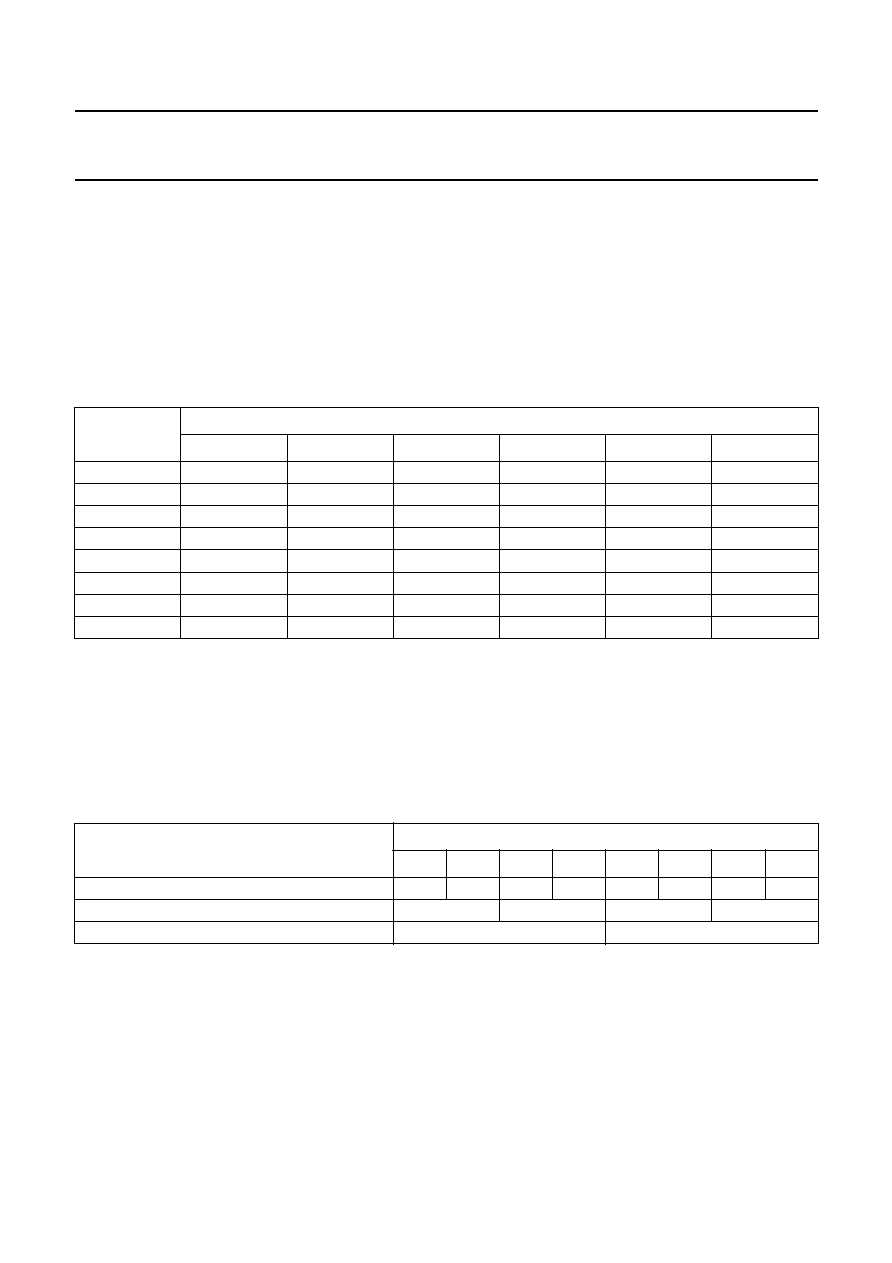
1999 May 31
9
Philips Semiconductors
Product specification
Digital video encoder
SAA7126H; SAA7127H
Input levels and formats
The SAA7126H; SAA7127H expects digital Y, Cb, Cr data
with levels (digital codes) in accordance with
"CCIR 601".
For C and CVBS outputs, deviating amplitudes of the
colour difference signals can be compensated by
independent gain control setting, while gain for luminance
is set to predefined values, distinguishable for 7.5 IRE
set-up or without set-up.
The RGB, respectively Cr-Y-Cb path features a gain
setting individually for luminance (GY) and colour
difference signals (GCD).
Reference levels are measured with a colour bar,
100% white, 100% amplitude and 100% saturation.
Table 1
"CCIR 601" signal component levels
Notes
1. Transformation:
a) R = Y + 1.3707
◊
(Cr
-
128)
b) G = Y
-
0.3365
◊
(Cb
-
128)
-
0.6982
◊
(Cr
-
128)
c) B = Y + 1.7324
◊
(Cb
-
128).
2. Representation of R, G and B (or Cr, Y and Cb) at the output is 9 bits at 27 MHz.
Table 2
8-bit multiplexed format (similar to
"CCIR 601")
COLOUR
SIGNALS
(1)
Y
Cb
Cr
R
(2)
G
(2)
B
(2)
White
235
128
128
235
235
235
Yellow
210
16
146
235
235
16
Cyan
170
166
16
16
235
235
Green
145
54
34
16
235
16
Magenta
106
202
222
235
16
235
Red
81
90
240
235
16
16
Blue
41
240
110
16
16
235
Black
16
128
128
16
16
16
TIME
BITS
0
1
2
3
4
5
6
7
Sample
Cb
0
Y
0
Cr
0
Y
1
Cb
2
Y
2
Cr
2
Y
3
Luminance pixel number
0
1
2
3
Colour pixel number
0
2
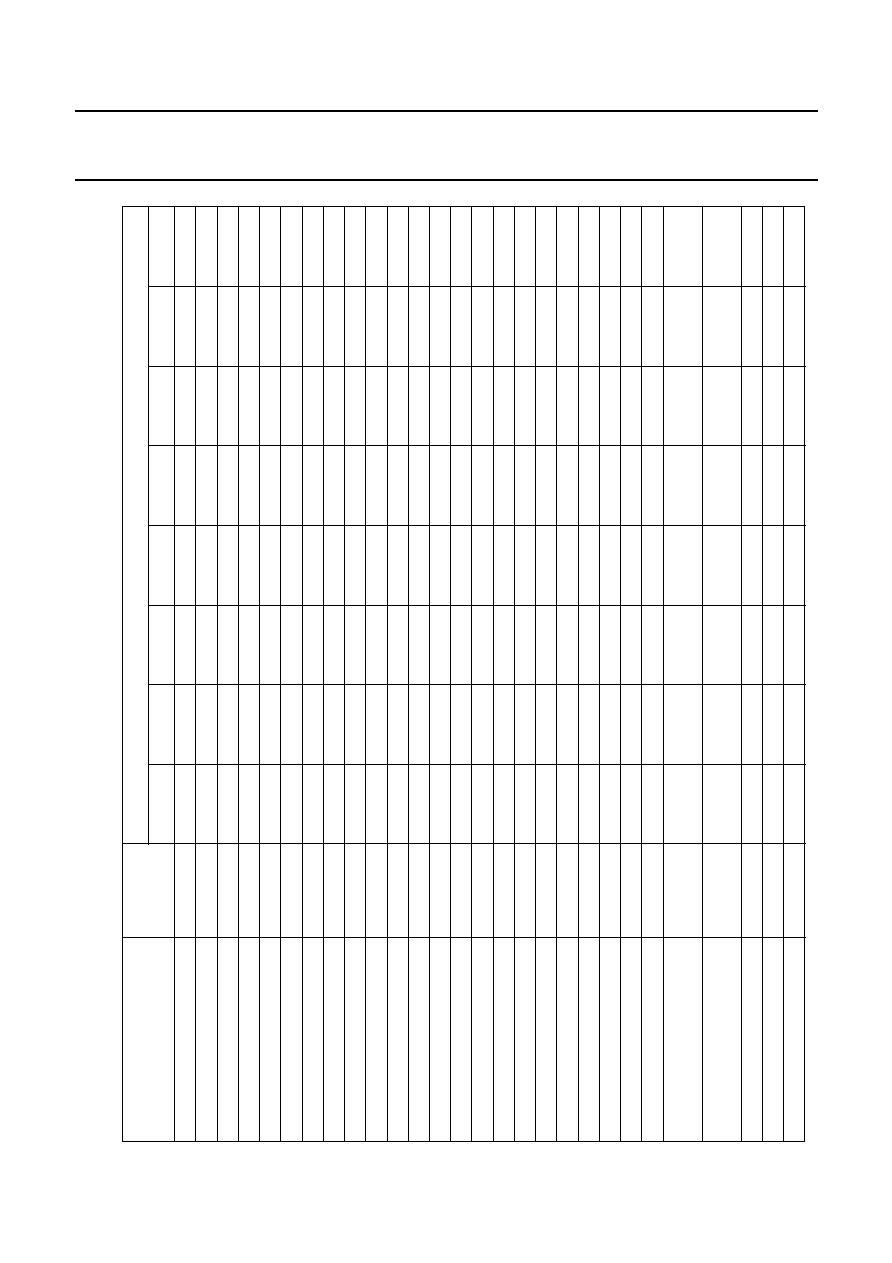
1999
May
31
10
Philips Semiconductors
Product specification
Digital video encoder
SAA7126H; SAA7127H
This text is here in white to force landscape pages to be rotated correctly when browsing through the pdf in the Acrobat reader.This text is here in
_
white to force landscape pages to be rotated correctly when browsing through the pdf in the Acrobat reader.This text is here inThis text is here in
white to force landscape pages to be rotated correctly when browsing through the pdf in the Acrobat reader. white to force landscape pages to be ...
Bit allocation map
Table 3
Slave receiver (slave address 88H)
REGISTER FUNCTION
SUB ADDR
(HEX)
DATA BYTE
(1)
D7
D6
D5
D4
D3
D2
D1
D0
Status byte (read only)
00H
VER2
VER1
VER0
CCRDO
CCRDE
0
FSEQ
O_E
Null
01H to 25H
0
0
0
0
0
0
0
0
Wide screen signal
26H
WSS7
WSS6
WSS5
WSS4
WSS3
WSS2
WSS1
WSS0
Wide screen signal
27H
WSSON
0
WSS13
WSS12
WSS11
WSS10
WSS9
WSS8
Real-time control, burst start
28H
DECCOL
DECFIS
BS5
BS4
BS3
BS2
BS1
BS0
Sync reset enable, burst end
29H
SRES
0
BE5
BE4
BE3
BE2
BE1
BE0
Copy generation 0
2AH
CG07
CG06
CG05
CG04
CG03
CG02
CG01
CG00
Copy generation 1
2BH
CG15
CG14
CG13
CG12
CG11
CG10
CG09
CG08
CG enable, copy generation 2
2CH
CGEN
0
0
0
CG19
CG18
CG17
CG16
Output port control
2DH
VBSEN1
VBSEN0
CVBSEN
CEN
CVBSTRI
RTRI
GTRI
BTRI
Null
2EH to 37H
0
0
0
0
0
0
0
0
Gain luminance for RGB
38H
0
0
0
GY4
GY3
GY2
GY1
GY0
Gain colour difference for RGB
39H
0
0
0
GCD4
GCD3
GCD2
GCD1
GCD0
Input port control 1
3AH
CBENB
0
0
SYMP
DEMOFF
CSYNC
MP2C2
MP2C1
VPS enable, input control 2
54H
VPSEN
CCIRS
0
0
0
0
EDGE2
EDGE1
VPS byte 5
55H
VPS57
VPS56
VPS55
VPS54
VPS53
VPS52
VPS51
VPS50
VPS byte 11
56H
VPS117
VPS116
VPS115
VPS114
VPS113
VPS112
VPS111
VPS110
VPS byte 12
57H
VPS127
VPS126
VPS125
VPS124
VPS123
VPS122
VPS121
VPS120
VPS byte 13
58H
VPS137
VPS136
VPS135
VPS134
VPS133
VPS132
VPS131
VPS130
VPS byte 14
59H
VPS147
VPS146
VPS145
VPS144
VPS143
VPS142
VPS141
VPS140
Chrominance phase
5AH
CHPS7
CHPS6
CHPS5
CHPS4
CHPS3
CHPS2
CHPS1
CHPS0
Gain U
5BH
GAINU7
GAINU6
GAINU5
GAINU4
GAINU3
GAINU2
GAINU1
GAINU0
Gain V
5CH
GAINV7
GAINV6
GAINV5
GAINV4
GAINV3
GAINV2
GAINV1
GAINV0
Gain U MSB, real-time control,
black level
5DH
GAINU8
DECOE
BLCKL5
BLCKL4
BLCKL3
BLCKL2
BLCKL1
BLCKL0
Gain V MSB, real-time
control, blanking level
5EH
GAINV8
DECPH
BLNNL5
BLNNL4
BLNNL3
BLNNL2
BLNNL1
BLNNL0
CCR, blanking level VBI
5FH
CCRS1
CCRS0
BLNVB5
BLNVB4
BLNVB3
BLNVB2
BLNVB1
BLNVB0
Null
60H
0
0
0
0
0
0
0
0
Standard control
61H
DOWNB
DOWNA
INPI
YGS
0
SCBW
PAL
FISE
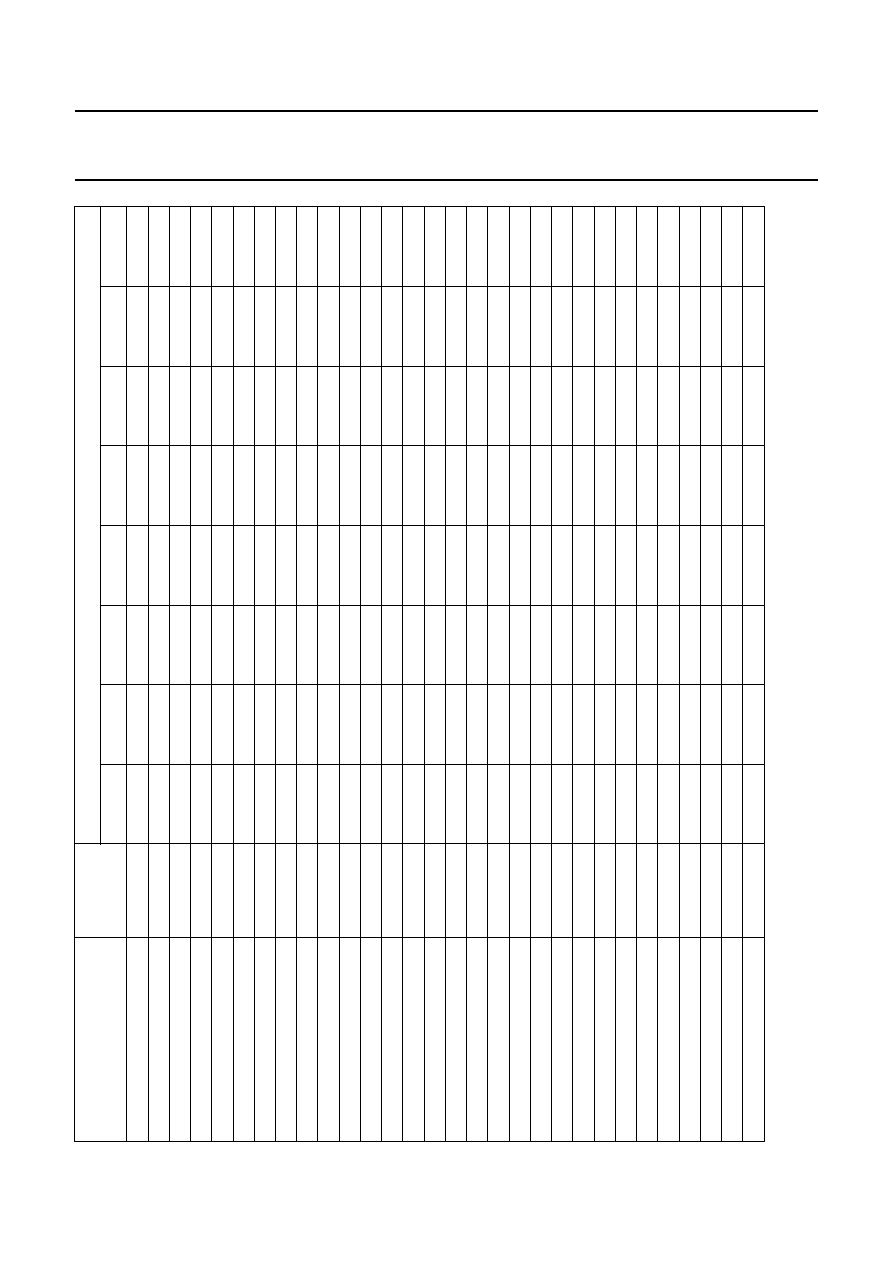
1999
May
31
11
Philips Semiconductors
Product specification
Digital video encoder
SAA7126H; SAA7127H
This text is here in white to force landscape pages to be rotated correctly when browsing through the pdf in the Acrobat reader.This text is here in
_
white to force landscape pages to be rotated correctly when browsing through the pdf in the Acrobat reader.This text is here inThis text is here in
white to force landscape pages to be rotated correctly when browsing through the pdf in the Acrobat reader. white to force landscape pages to be ...
Note
1. All bits labelled `0' are reserved. They must be programmed with logic 0.
RTC enable, burst amplitude
62H
RTCE
BSTA6
BSTA5
BSTA4
BSTA3
BSTA2
BSTA1
BSTA0
Subcarrier 0
63H
FSC07
FSC06
FSC05
FSC04
FSC03
FSC02
FSC01
FSC00
Subcarrier 1
64H
FSC15
FSC14
FSC13
FSC12
FSC11
FSC10
FSC09
FSC08
Subcarrier 2
65H
FSC23
FSC22
FSC21
FSC20
FSC19
FSC18
FSC17
FSC16
Subcarrier 3
66H
FSC31
FSC30
FSC29
FSC28
FSC27
FSC26
FSC25
FSC24
Line 21 odd 0
67H
L21O07
L21O06
L21O05
L21O04
L21O03
L21O02
L21O01
L21O00
Line 21 odd 1
68H
L21O17
L21O16
L21O15
L21O14
L21O13
L21O12
L21O11
L21O10
Line 21 even 0
69H
L21E07
L21E06
L21E05
L21E04
L21E03
L21E02
L21E01
L21E00
Line 21 even 1
6AH
L21E17
L21E16
L21E15
L21E14
L21E13
L21E12
L21E11
L21E10
RCV port control
6BH
SRCV11
SRCV10
TRCV2
ORCV1
PRCV1
CBLF
ORCV2
PRCV2
Trigger control
6CH
HTRIG7
HTRIG6
HTRIG5
HTRIG4
HTRIG3
HTRIG2
HTRIG1
HTRIG0
Trigger control
6DH
HTRIG10
HTRIG9
HTRIG8
VTRIG4
VTRIG3
VTRIG2
VTRIG1
VTRIG0
Multi control
6EH
SBLBN
BLCKON
PHRES1
PHRES0
LDEL1
LDEL0
FLC1
FLCO
Closed caption, teletext enable
6FH
CCEN1
CCEN0
TTXEN
SCCLN4
SCCLN3
SCCLN2
SCCLN1
SCCLN0
RCV2 output start
70H
RCV2S7
RCV2S6
RCV2S5
RCV2S4
RCV2S3
RCV2S2
RCV2S1
RCV2S0
RCV2 output end
71H
RCV2E7
RCV2E6
RCV2E5
RCV2E4
RCV2E3
RCV2E2
RCV2E1
RCV2E0
MSBs RCV2 output
72H
0
RCV2E10
RCV2E9
RCV2E8
0
RCV2S10
RCV2S9
RCV2S8
TTX request H start
73H
TTXHS7
TTXHS6
TTXHS5
TTXHS4
TTXHS3
TTXHS2
TTXHS1
TTXHS0
TTX request H delay, length
74H
TTXHL3
TTXHL2
TTXHL1
TTXHL0
TTXHD3
TTXHD2
TTXHD1
TTXHD0
CSYNC advance, Vsync shift
75H
CSYNCA4 CSYNCA3 CSYNCA2 CSYNCA1 CSYNCA0
VS_S2
VS_S1
VS_S0
TTX odd request vertical start
76H
TTXOVS7
TTXOVS6
TTXOVS5
TTXOVS4
TTXOVS3
TTXOVS2
TTXOVS1
TTXOVS0
TTX odd request vertical end
77H
TTXOVE7
TTXOVE6
TTXOVE5
TTXOVE4
TTXOVE3
TTXOVE2
TTXOVE1
TTXOVE0
TTX even request vertical start
78H
TTXEVS7
TTXEVS6
TTXEVS5
TTXEVS4
TTXEVS3
TTXEVS2
TTXEVS1
TTXEVS0
TTX even request vertical end
79H
TTXEVE7
TTXEVE6
TTXEVE5
TTXEVE4
TTXEVE3
TTXEVE2
TTXEVE1
TTXEVE0
First active line
7AH
FAL7
FAL6
FAL5
FAL4
FAL3
FAL2
FAL1
FAL0
Last active line
7BH
LAL7
LAL6
LAL5
LAL4
LAL3
LAL2
LAL1
LAL0
TTX mode, MSB vertical
7CH
TTX60
LAL8
TTXO
FAL8
TTXEVE8
TTXOVE8
TTXEVS8
TTXOVS8
Null
7DH
0
0
0
0
0
0
0
0
Disable TTX line
7EH
LINE12
LINE11
LINE10
LINE9
LINE8
LINE7
LINE6
LINE5
Disable TTX line
7FH
LINE20
LINE19
LINE18
LINE17
LINE16
LINE15
LINE14
LINE13
REGISTER FUNCTION
SUB ADDR
(HEX)
DATA BYTE
(1)
D7
D6
D5
D4
D3
D2
D1
D0

1999 May 31
12
Philips Semiconductors
Product specification
Digital video encoder
SAA7126H; SAA7127H
I
2
C-bus format
Table 4
I
2
C-bus address; see Table 5
Table 5
Explanation of Table 4
Notes
1. X is the read/write control bit; X = logic 0 is order to write; X = logic 1 is order to read.
2. If more than 1 byte of DATA is transmitted, then auto-increment of the subaddress is performed.
Slave receiver
Table 6
Subaddresses 26H and 27H
Table 7
Subaddress 28H
S
SLAVE ADDRESS
ACK
SUBADDRESS
ACK
DATA 0
ACK
--------
DATA n
ACK
P
PART
DESCRIPTION
S
START condition
Slave address
1 0 0 0 1 0 0 X or 1 0 0 0 1 1 0 X; note 1
ACK
acknowledge, generated by the slave
Subaddress; note 2
subaddress byte
DATA
data byte
--------
continued data bytes and ACKs
P
STOP condition
DATA BYTE
LOGIC
LEVEL
DESCRIPTION
WSS
-
wide screen signalling bits
3 to 0 = aspect ratio
7 to 4 = enhanced services
10 to 8 = subtitles
13 to 11 = reserved
WSSON
0
wide screen signalling output is disabled; default after reset
1
wide screen signalling output is enabled
DATA BYTE
LOGIC
LEVEL
DESCRIPTION
REMARKS
BS
-
starting point of burst in clock cycles
PAL: BS = 33 (21H); default after reset
NTSC: BS = 25 (19H)
DECCOL
0
disable colour detection bit of RTCI input
1
enable colour detection bit of RTCI input
bit RTCE must be set to logic 1 (see Fig.13)
DECFIS
0
field sequence as FISE in subaddress 61
1
field sequence as FISE bit in RTCI input
bit RTCE must be set to logic 1 (see Fig.13)

1999 May 31
13
Philips Semiconductors
Product specification
Digital video encoder
SAA7126H; SAA7127H
Table 8
Subaddress 29H
Table 9
Subaddresses 2AH to 2CH
Table 10 Subaddress 2DH
DATA BYTE
LOGIC
LEVEL
DESCRIPTION
REMARKS
BE
-
ending point of burst in clock cycles
PAL: BE = 29 (1DH); default after reset
NTSC: BE = 29 (1DH)
SRES
0
pin 19 is Real-Time Control Input (RTCI)
1
pin 19 is Sync Reset input (SRES)
a HIGH impulse resets synchronization of the
encoder (first field, first line)
DATA BYTE
LOGIC
LEVEL
DESCRIPTION
CG
-
LSB of the respective bytes are encoded immediately after run-in, the MSBs of the
respective bytes have to carry the CRCC bits, in accordance with the definition of copy
generation management system encoding format.
CGEN
0
copy generation data output is disabled; default after reset
1
copy generation data output is enabled
DATA BYTE
LOGIC
LEVEL
DESCRIPTION
BTRI
0
DAC for BLUE output in 3-state mode (high-impedance)
1
DAC for BLUE output in normal operation mode; default after reset
GTRI
0
DAC for GREEN output in 3-state mode (high-impedance)
1
DAC for GREEN output in normal operation mode; default after reset
RTRI
0
DAC for RED output in 3-state mode (high-impedance)
1
DAC for RED output in normal operation mode; default after reset
CVBSTRI
0
DAC for CVBS output in 3-state mode (high-impedance)
1
DAC for CVBS output in normal operation mode; default after reset
CEN
0
RED output signal is switched to R DAC; default after reset
1
chrominance output signal is switched to R DAC
CVBSEN
0
BLUE output signal is switched to B DAC; default after reset
1
CVBS output signal is switched to B DAC
VBSEN0
0
if CSYNC = 0, CVBS output signal is switched to CVBS DAC; default after reset
1
if CSYNC = 0, luminance (VBS) output signal is switched to CVBS DAC
VBSEN1
0
GREEN output signal is switched to G DAC; default after reset
1
luminance (VBS) output signal is switched to G DAC
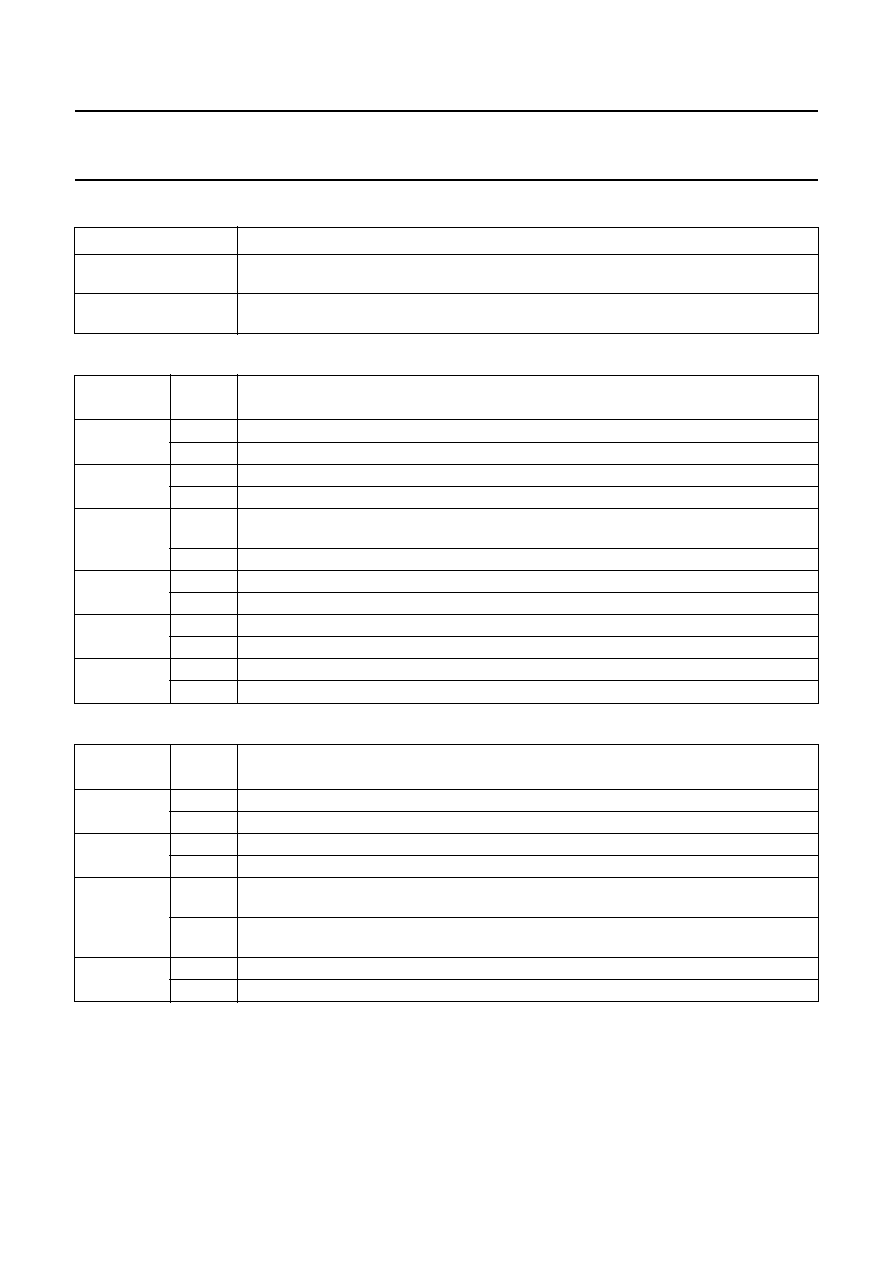
1999 May 31
14
Philips Semiconductors
Product specification
Digital video encoder
SAA7126H; SAA7127H
Table 11 Subaddresses 38H and 39H
Table 12 Subaddress 3AH
Table 13 Subaddress 54H
DATA BYTE
DESCRIPTION
GY0 to GY4
gain luminance of RGB (Cr, Y and Cb) output, ranging from (1
-
16
/
32
) to (1 +
15
/
32
).
Suggested nominal value =
-
6 (11010b), depending on external application.
GCD0 to GCD4
gain colour difference of RGB (Cr, Y and Cb) output, ranging from (1
-
16
/
32
) to (1 +
15
/
32
).
Suggested nominal value =
-
6 (11010b), depending on external application.
DATA BYTE
LOGIC
LEVEL
DESCRIPTION
MP2C1
0
input data is twos complement from MP1 input port (encoder path)
1
input data is straight binary from MP1 input port; default after reset
MP2C2
0
input data is twos complement from MP2 input port (RGB path)
1
input data is straight binary from MP2 input port; default after reset
CSYNC
0
If VBSEN0 = 0, CVBS output signal is switched to CVBS DAC.
If VBSEN0 = 1, luminance output signal is switched to CVBS DAC; default after reset.
1
advanced composite sync is switched to CVBS DAC
DEMOFF
0
Y, Cb and Cr for RGB dematrix is active; default after reset
1
Y, Cb and Cr for RGB dematrix is bypassed
SYMP
0
horizontal and vertical trigger is taken from RCV2 and RCV1 respectively; default after reset
1
horizontal and vertical trigger is decoded out of
"CCIR 656" compatible data at MP port
CBENB
0
data from input ports is encoded; default after reset
1
colour bar with fixed colours is encoded
DATA BYTE
LOGIC
LEVEL
DESCRIPTION
EDGE1
0
MP1 data is sampled on the rising clock edge; default after reset
1
MP1 data is sampled on the falling clock edge
EDGE2
0
MP2 data is sampled on the rising clock edge; default after reset
1
MP2 data is sampled on the falling clock edge
CCIRS
0
If SYMP = 1, horizontal and vertical trigger is decoded out of
"CCIR 656" compatible data at
MP2 port; default after reset.
1
If SYMP = 1, horizontal and vertical trigger is decoded out of
"CCIR 656" compatible data at
MP1 port.
VPSEN
0
video programming system data insertion is disabled; default after reset
1
video programming system data insertion in line 16 is enabled

1999 May 31
15
Philips Semiconductors
Product specification
Digital video encoder
SAA7126H; SAA7127H
Table 14 Subaddresses 55H to 59H
Table 15 Subaddress 5AH
Table 16 Subaddresses 5BH and 5DH
Table 17 Subaddresses 5CH and 5EH
DATA BYTE
DESCRIPTION
REMARKS
VPS5
fifth byte of video programming system data
LSBs of the respective bytes are encoded
immediately after run-in and framing code in
line 16; all other bytes are not relevant for
VPS
VPS11
eleventh byte of video programming system data
VPS12
twelfth byte of video programming system data
VPS13
thirteenth byte of video programming system data
VPS14
fourteenth byte of video programming system data
DATA BYTE
DESCRIPTION
VALUE
RESULT
CHPS
phase of encoded colour subcarrier
(including burst) relative to horizontal
sync; can be adjusted in steps of
360/256 degrees
6BH
PAL-B/G and data from input ports
95H
PAL-B/G and data from look-up table
A3H
NTSC-M and data from input ports
46H
NTSC-M and data from look-up table
DATA BYTE
DESCRIPTION
CONDITIONS
REMARKS
GAINU
variable gain for
Cb signal; input
representation in
accordance with
"CCIR 601"
white-to-black = 92.5 IRE
GAINU =
-
2.17
◊
nominal to +2.16
◊
nominal
GAINU = 0
output subcarrier of U contribution = 0
GAINU = 118 (76H)
output subcarrier of U contribution = nominal
white-to-black = 100 IRE
GAINU =
-
2.05
◊
nominal to +2.04
◊
nominal
GAINU = 0
output subcarrier of U contribution = 0
GAINU = 125 (7DH)
output subcarrier of U contribution = nominal
DATA BYTE
DESCRIPTION
CONDITIONS
REMARKS
GAINV
variable gain for
Cr signal; input
representation in
accordance with
"CCIR 601"
white-to-black = 92.5 IRE
GAINV =
-
1.55
◊
nominal to +1.55
◊
nominal
GAINV = 0
output subcarrier of V contribution = 0
GAINV = 165 (A5H)
output subcarrier of V contribution = nominal
white-to-black = 100 IRE
GAINV =
-
1.46
◊
nominal to +1.46
◊
nominal
GAINV = 0
output subcarrier of V contribution = 0
GAINV = 175 (AFH)
output subcarrier of V contribution = nominal
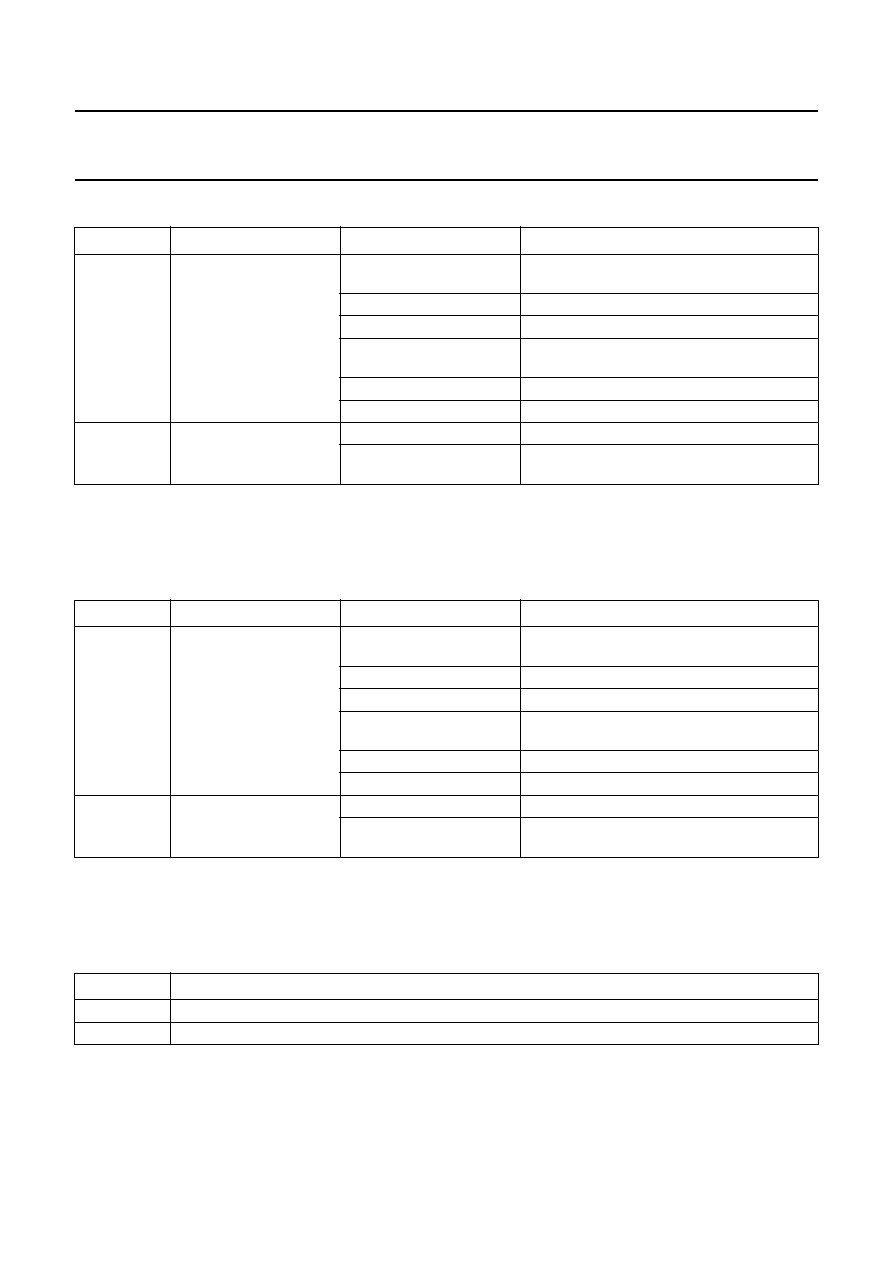
1999 May 31
16
Philips Semiconductors
Product specification
Digital video encoder
SAA7126H; SAA7127H
Table 18 Subaddress 5DH
Notes
1. Output black level/IRE = BLCKL
◊
2/6.29 + 28.9.
2. Output black level/IRE = BLCKL
◊
2/6.18 + 26.5.
Table 19 Subaddress 5EH
Notes
1. Output black level/IRE = BLNNL
◊
2/6.29 + 25.4.
2. Output black level/IRE = BLNNL
◊
2/6.18 + 25.9; default after reset: 35H.
Table 20 Subaddress 5FH
DATA BYTE
DESCRIPTION
CONDITIONS
REMARKS
BLCKL
variable black level; input
representation in
accordance with
"CCIR 601"
white-to-sync = 140 IRE;
note 1
recommended value: BLCKL = 58 (3AH)
BLCKL = 0; note 1
output black level = 29 IRE
BLCKL = 63 (3FH); note 1
output black level = 49 IRE
white-to-sync = 143 IRE;
note 2
recommended value: BLCKL = 51 (33H)
BLCKL = 0; note 2
output black level = 27 IRE
BLCKL = 63 (3FH); note 2
output black level = 47 IRE
DECOE
real-time control
logic 0
disable odd/even field control bit from RTCI
logic 1
enable odd/even field control bit from RTCI
(see Fig.13)
DATA BYTE
DESCRIPTION
CONDITIONS
REMARKS
BLNNL
variable blanking level
white-to-sync = 140 IRE;
note 1
recommended value: BLNNL = 46 (2EH)
BLNNL = 0; note 1
output blanking level = 25 IRE
BLNNL = 63 (3FH); note 1
output blanking level = 45 IRE
white-to-sync = 143 IRE;
note 2
recommended value: BLNNL = 53 (35H)
BLNNL = 0; note 2
output blanking level = 26 IRE
BLNNL = 63 (3FH); note 2
output blanking level = 46 IRE
DECPH
real-time control
logic 0
disable subcarrier phase reset bit from RTCI
logic 1
enable subcarrier phase reset bit from RTCI
(see Fig.13)
DATA BYTE
DESCRIPTION
BLNVB
variable blanking level during vertical blanking interval is typically identical to value of BLNNL
CCRS
select cross-colour reduction filter in luminance; see Table 21

1999 May 31
17
Philips Semiconductors
Product specification
Digital video encoder
SAA7126H; SAA7127H
Table 21 Logic levels and function of CCRS
Table 22 Subaddress 61H
Table 23 Subaddress 62AH
CCRS1
CCRS0
DESCRIPTION
0
0
no cross-colour reduction; for overall transfer characteristic of luminance see Fig.5
0
1
cross-colour reduction #1 active; for overall transfer characteristic see Fig.5
1
0
cross-colour reduction #2 active; for overall transfer characteristic see Fig.5
1
1
cross-colour reduction #3 active; for overall transfer characteristic see Fig.5
DATA BYTE
LOGIC
LEVEL
DESCRIPTION
FISE
0
864 total pixel clocks per line; default after reset
1
858 total pixel clocks per line
PAL
0
NTSC encoding (non-alternating V component)
1
PAL encoding (alternating V component); default after reset
SCBW
0
enlarged bandwidth for chrominance encoding (for overall transfer characteristic of
chrominance in baseband representation see Figs 3 and 4)
1
standard bandwidth for chrominance encoding (for overall transfer characteristic of
chrominance in baseband representation see Figs 3 and 4); default after reset
YGS
0
luminance gain for white
-
black 100 IRE; default after reset
1
luminance gain for white
-
black 92.5 IRE including 7.5 IRE set-up of black
INPI
0
PAL switch phase is nominal; default after reset
1
PAL switch phase is inverted compared to nominal if RTC is enabled (see Table 23)
DOWNA
0
DAC for CVBS in normal operational mode; default after reset
1
DAC for CVBS forced to lowest output voltage
DOWNB
0
DACs for R, G and B in normal operational mode
1
DACs for R, G and B forced to lowest output voltage; default after reset
DATA BYTE
LOGIC
LEVEL
DESCRIPTION
RTCE
0
no real-time control of generated subcarrier frequency; default after reset
1
real-time control of generated subcarrier frequency through SAA7151B or SAA7111; for
timing see Fig.13

1999 May 31
18
Philips Semiconductors
Product specification
Digital video encoder
SAA7126H; SAA7127H
Table 24 Subaddress 62BH
Table 25 Subaddresses 63H to 66H (four bytes to program subcarrier frequency)
Note
1. Examples:
a) NTSC-M: f
fsc
= 227.5, f
llc
= 1716
FSC = 569408543 (21F07C1FH).
b) PAL-B/G: f
fsc
= 283.7516, f
llc
= 1728
FSC = 705268427 (2A098ACBH).
Table 26 Subaddresses 67H to 6AH
DATA BYTE
DESCRIPTION
CONDITIONS
REMARKS
BSTA
amplitude of colour burst;
input representation in
accordance with
"CCIR 601"
white-to-black = 92.5 IRE;
burst = 40 IRE; NTSC encoding
recommended value:
BSTA = 63 (3FH)
BSTA = 0 to 2.02
◊
nominal
white-to-black = 92.5 IRE;
burst = 40 IRE; PAL encoding
recommended value:
BSTA = 45 (2DH)
BSTA = 0 to 2.82
◊
nominal
white-to-black = 100 IRE;
burst = 43 IRE; NTSC encoding
recommended value:
BSTA = 67 (43H)
BSTA = 0 to 1.90
◊
nominal
white-to-black = 100 IRE;
burst = 43 IRE; PAL encoding
recommended value:
BSTA = 47 (2FH); default after
reset
BSTA = 0 to 3.02
◊
nominal
DATA BYTE
DESCRIPTION
CONDITIONS
REMARKS
FSC0 to FSC3
f
fsc
= subcarrier frequency
(in multiples of line
frequency); f
llc
= clock
frequency (in multiples of
line frequency)
;
note 1
FSC3 = most significant byte;
FSC0 = least significant byte
DATA BYTE
DESCRIPTION
REMARKS
L21O0
first byte of captioning data, odd field
LSBs of the respective bytes are encoded
immediately after run-in and framing code, the
MSBs of the respective bytes have to carry the
parity bit, in accordance with the definition of
line 21 encoding format.
L21O1
second byte of captioning data, odd field
L21E0
first byte of extended data, even field
L21E1
second byte of extended data, even field
FSC
round
f
fsc
f
llc
--------
2
32
◊
=

1999 May 31
19
Philips Semiconductors
Product specification
Digital video encoder
SAA7126H; SAA7127H
Table 27 Subaddress 6BH
Table 28 Logic levels and function of SRCV1
Table 29 Subaddresses 6CH and 6DH
DATA BYTE
LOGIC
LEVEL
DESCRIPTION
PRCV2
0
polarity of RCV2 as output is active HIGH, rising edge is taken when input, respectively;
default after reset
1
polarity of RCV2 as output is active LOW, falling edge is taken when input, respectively
ORCV2
0
pin RCV2 is switched to input; default after reset
1
pin RCV2 is switched to output
CBLF
0
If ORCV2 = HIGH, pin RCV2 provides an HREF signal (horizontal reference pulse that is
defined by RCV2S and RCV2E, also during vertical blanking interval); default after reset.
If ORCV2 = LOW and bit SYMP = LOW, the signal input to RCV2 is used for horizontal
synchronization only (if TRCV2 = 1); default after reset.
1
If ORCV2 = HIGH, pin RCV2 provides a `composite-blanking-not' signal, for example a
reference pulse that is defined by RCV2S and RCV2E, excluding vertical blanking interval,
which is defined by FAL and LAL. If ORCV2 = LOW and bit SYMP = LOW, the signal input
to RCV2 is used for horizontal synchronization (if TRCV2 = 1) and as an internal blanking
signal.
PRCV1
0
polarity of RCV1 as output is active HIGH, rising edge is taken when input; default after
reset
1
polarity of RCV1 as output is active LOW, falling edge is taken when input
ORCV1
0
pin RCV1 is switched to input; default after reset
1
pin RCV1 is switched to output
TRCV2
0
horizontal synchronization is taken from RCV1 port (at bit SYMP = LOW) or from decoded
frame sync of
"CCIR 656" input (at bit SYMP = HIGH); default after reset
1
horizontal synchronization is taken from RCV2 port (at bit SYMP = LOW)
SRCV1
-
defines signal type on pin RCV1; see Table 28
DATA BYTE
AS OUTPUT
AS INPUT
FUNCTION
SRCV11
SRCV10
0
0
VS
VS
vertical sync each field; default after reset
0
1
FS
FS
frame sync (odd/even)
1
0
FSEQ
FSEQ
field sequence, vertical sync every fourth field (PAL = 0)
or eighth field (PAL = 1)
1
1
not applicable
not applicable
-
DATA BYTE
DESCRIPTION
HTRIG
sets the horizontal trigger phase related to signal on RCV1 or RCV2 input
values above 1715 (FISE = 1) or 1727 (FISE = 0) are not allowed; increasing HTRIG
decreases delays of all internally generated timing signals; reference mark: analog output
horizontal sync (leading slope) coincides with active edge of RCV used for triggering at
HTRIG = 39H
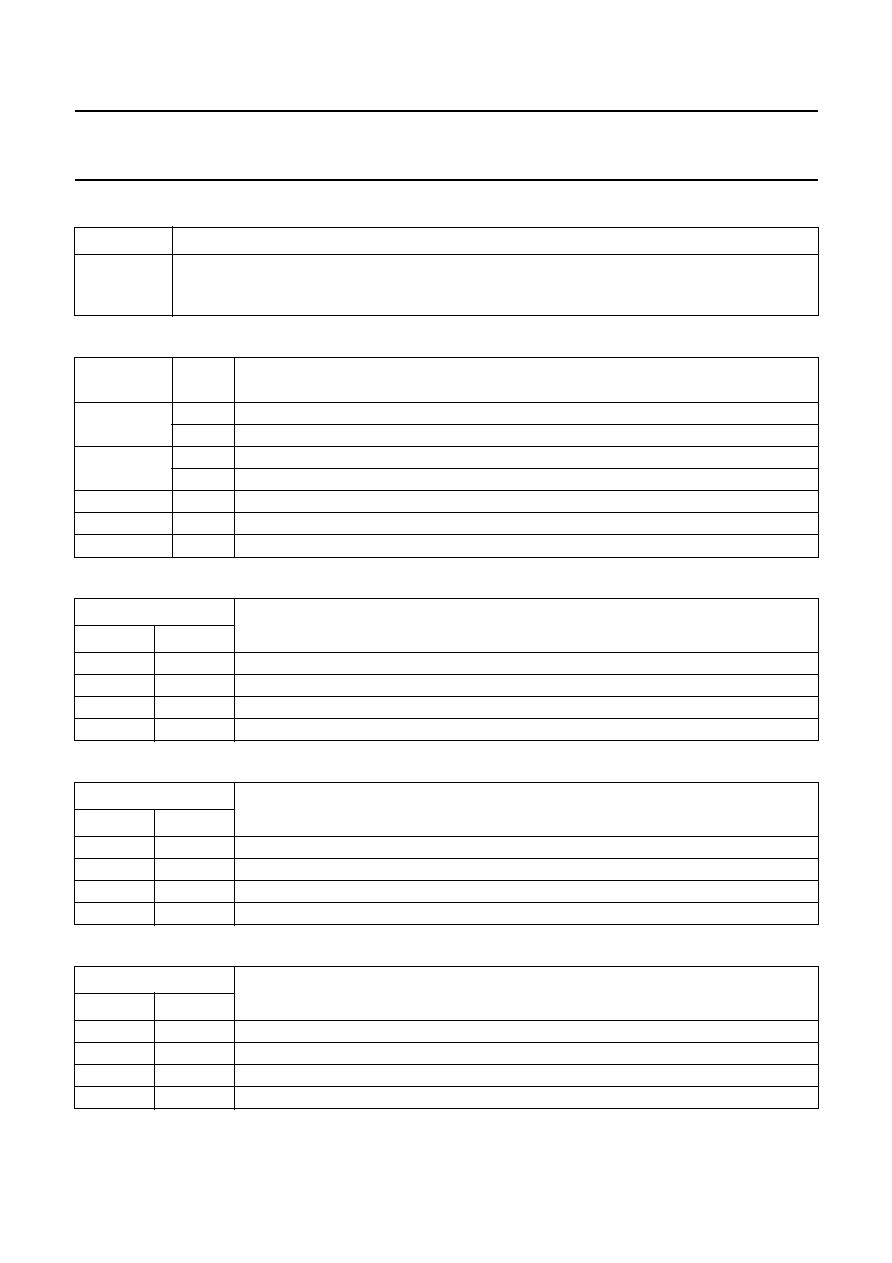
1999 May 31
20
Philips Semiconductors
Product specification
Digital video encoder
SAA7126H; SAA7127H
Table 30 Subaddress 6DH
Table 31 Subaddress 6EH
Table 32 Logic levels and function of PHRES
Table 33 Logic levels and function of LDEL
Table 34 Logic levels and function of FLC
DATA BYTE
DESCRIPTION
VTRIG
sets the vertical trigger phase related to signal on RCV1 input
increasing VTRIG decreases delays of all internally generated timing signals, measured in half lines;
variation range of VTRIG = 0 to 31 (1FH)
DATA BYTE
LOGIC
LEVEL
DESCRIPTION
SBLBN
0
vertical blanking is defined by programming of FAL and LAL; default after reset
1
vertical blanking is forced in accordance with
"CCIR 624" (50 Hz) or RS170A (60 Hz)
BLCKON
0
encoder in normal operation mode
1
output signal is forced to blanking level; default after reset
PHRES
-
selects the phase reset mode of the colour subcarrier generator; see Table 32
LDEL
-
selects the delay on luminance path with reference to chrominance path; see Table 33
FLC
-
field length control; see Table 34
DATA BYTE
DESCRIPTION
PHRES1
PHRES0
0
0
no reset or reset via RTCI from SAA7111 if bit RTCE = 1; default after reset
0
1
reset every two lines
1
0
reset every eight fields
1
1
reset every four fields
DATA BYTE
DESCRIPTION
LDEL1
LDEL0
0
0
no luminance delay; default after reset
0
1
1 LLC luminance delay
1
0
2 LLC luminance delay
1
1
3 LLC luminance delay
DATA BYTE
DESCRIPTION
FLC1
FLC0
0
0
interlaced 312.5 lines/field at 50 Hz, 262.5 lines/field at 60 Hz; default after reset
0
1
non-interlaced 312 lines/field at 50 Hz, 262 lines/field at 60 Hz
1
0
non-interlaced 313 lines/field at 50 Hz, 263 lines/field at 60 Hz
1
1
non-interlaced 313 lines/field at 50 Hz, 263 lines/field at 60 Hz

1999 May 31
21
Philips Semiconductors
Product specification
Digital video encoder
SAA7126H; SAA7127H
Table 35 Subaddress 6FH
Table 36 Logic levels and function of CCEN
Table 37 Subaddresses 70H to 72H
Table 38 Subaddress 73H
Table 39 Subaddress 74H
DATA BYTE
LOGIC
LEVEL
DESCRIPTION
CCEN
-
enables individual line 21 encoding; see Table 36
TTXEN
0
disables teletext insertion; default after reset
1
enables teletext insertion
SCCLN
-
selects the actual line, where closed caption or extended data are encoded;
line = (SCCLN + 4) for M-systems; line = (SCCLN + 1) for other systems
DATA BYTE
DESCRIPTION
CCEN1
CCEN0
0
0
line 21 encoding off; default after reset
0
1
enables encoding in field 1 (odd)
1
0
enables encoding in field 2 (even)
1
1
enables encoding in both fields
DATA BYTE
DESCRIPTION
RCV2S
start of output signal on RCV2 pin
values above 1715 (FISE = 1) or [1727 (FISE = 0)] are not allowed; first active pixel at analog
outputs (corresponding input pixel coinciding with RCV2) at RCV2S = 11AH [0FDH]
RCV2E
end of output signal on RCV2 pin
values above 1715 (FISE = 1) or [1727 (FISE = 0)] are not allowed; last active pixel at analog
outputs (corresponding input pixel coinciding with RCV2) at RCV2E = 694H (687H)
DATA BYTE
DESCRIPTION
REMARKS
TTXHS
start of signal on pin TTXRQ; see Fig.14
PAL: TTXHS = 42H
NTSC: TTXHS = 54H
DATA BYTE
DESCRIPTION
REMARKS
TTXHL
length of TTXRQ window; only active at old TTX protocol:
bit TTXO = 1
TTXHL = 0: TTXRQ = 1398LLC;
TTXHL = 15: TTXRQ = 1413LLC
TTXHD
indicates the delay in clock cycles between rising edge of TTXRQ
output and valid data at pin TTX
minimum value: TTXHD = 2

1999 May 31
22
Philips Semiconductors
Product specification
Digital video encoder
SAA7126H; SAA7127H
Table 40 Subaddress 75H
Table 41 Subaddresses 76H, 77H and 7CH
Table 42 Subaddresses 78H, 79H and 7CH
Table 43 Subaddress 7CH
Table 44 Subaddresses 7AH to 7CH
DATA BYTE
DESCRIPTION
VS_S
vertical sync shift between RCV1 and RCV2 (switched to output); in master mode it is possible to shift
H-sync (RCV2; CBLF = 0) against V-sync (RCV1; SRCV1 = 00)
standard value: VS_S = 3
CSYNCA
advanced composite sync against RGB output from 0LLC to 31LLC
DATA BYTE
DESCRIPTION
REMARKS
TTXOVS
first line of occurrence of signal on pin TTXRQ in odd field
PAL: TTXOVS = 05H;
NTSC: TTXOVS = 06H
line = (TTXOVS + 4) for M-systems
line = (TTXOVS + 1) for other systems
TTXOVE
last line of occurrence of signal on pin TTXRQ in odd field
PAL: TTXOVE = 16H;
NTSC: TTXOVE = 10H
line = (TTXOVE + 3) for M-systems
line = TTXOVE for other systems
DATA BYTE
DESCRIPTION
REMARKS
TTXEVS
first line of occurrence of signal on pin TTXRQ in even field
PAL: TTXEVS = 04H;
NTSC: TTXEVS = 05H
line = (TTXEVS + 4) for M-systems
line = (TTXEVS + 1) for other systems
TTXEVE
last line of occurrence of signal on pin TTXRQ in even field
PAL: TTXEVS = 16H;
NTSC: TTXEVS = 10H
line = (TTXEVE + 3) for M-systems
line = TTXEVE for other systems
DATA BYTE
LOGIC
LEVEL
DESCRIPTION
TTXO
0
new TTX protocol selected: at each rising edge of TTXRQ a single TTX bit is requested
see Fig.14; default after reset
1
old TTX protocol selected: the encoder provides a window of TTXRQ going HIGH; the
length of the window depends on the chosen TTX standard see Fig.14
TTX60
0
enables NABTS (FISE = 1) or European TTX (FISE = 0); default after reset
1
enables world standard teletext 60 Hz (FISE = 1)
DATA BYTE
DESCRIPTION
FAL
first active line = FAL + 4 for M-systems, = FAL + 1 for other systems, measured in lines
FAL = 0 coincides with the first field synchronization pulse
LAL
last active line = LAL + 3 for M-systems, = LAL for other system, measured in lines
LAL = 0 coincides with the first field synchronization pulse

1999 May 31
23
Philips Semiconductors
Product specification
Digital video encoder
SAA7126H; SAA7127H
Table 45 Subaddresses 7EH and 7FH
In subaddresses 5BH, 5CH, 5DH, 5EH and 62H all IRE values are rounded up.
Slave transmitter
Table 46 Slave transmitter (slave address 89H)
Table 47 Subaddress 00H
DATA BYTE
DESCRIPTION
LINE
individual lines in both fields (PAL counting) can be disabled for insertion of teletext by the respective
bits, disabled line = LINExx (50 Hz field rate)
this bit mask is effective only, if the lines are enabled by TTXOVS/TTXOVE and TTXEVS/TTXEVE
REGISTER
FUNCTION
SUBADDRESS
DATA BYTE
D7
D6
D5
D4
D3
D2
D1
D0
Status byte
00H
VER2
VER1
VER0
CCRDO
CCRDE
0
FSEQ
O_E
DATA BYTE
LOGIC
LEVEL
DESCRIPTION
VER
-
version identification of the device: it will be changed with all versions of the IC that have
different programming models; current version is 000 binary
CCRDO
1
closed caption bytes of the odd field have been encoded
0
the bit is reset after information has been written to the subaddresses 67H and 68H; it is
set immediately after the data has been encoded
CCRDE
1
closed caption bytes of the even field have been encoded
0
the bit is reset after information has been written to the subaddresses 69H and 6AH; it is
set immediately after the data has been encoded
FSEQ
1
during first field of a sequence (repetition rate: NTSC = 4 fields, PAL = 8 fields)
0
not first field of a sequence
O_E
1
during even field
0
during odd field

1999 May 31
24
Philips Semiconductors
Product specification
Digital video encoder
SAA7126H; SAA7127H
handbook, full pagewidth
6
8
10
12
14
6
0
0
2
4
MBE737
-
6
-
12
-
18
-
30
-
24
-
36
-
42
-
54
-
48
f (MHz)
Gv
(dB)
(1)
(2)
(1) SCBW = 1.
(2) SCBW = 0.
Fig.3 Chrominance transfer characteristic 1.
(1) SCBW = 1.
(2) SCBW = 0.
handbook, halfpage
0
0.4
0.8
1.6
2
0
-
4
-
6
-
2
MBE735
1.2
f (MHz)
Gv
(dB)
(1)
(2)
Fig.4 Chrominance transfer characteristic 2.

1999 May 31
25
Philips Semiconductors
Product specification
Digital video encoder
SAA7126H; SAA7127H
handbook, full pagewidth
6
(1)
(2)
(4)
(3)
8
10
12
14
6
0
0
2
4
MGD672
-
6
-
12
-
18
-
30
-
24
-
36
-
42
-
54
-
48
f (MHz)
Gv
(dB)
(1) CCRS1 = 0; CCRS0 = 1.
(2) CCRS1 = 1; CCRS0 = 0.
(3) CCRS1 = 1; CCRS0 = 1.
(4) CCRS1 = 0; CCRS0 = 0.
Fig.5 Luminance transfer characteristic 1.
handbook, halfpage
0
2
(1)
6
1
0
-
1
-
2
-
3
-
4
-
5
MBE736
4
f (MHz)
Gv
(dB)
(1) CCRS1 = 0; CCRS0 = 0.
Fig.6 Luminance transfer characteristic 2.
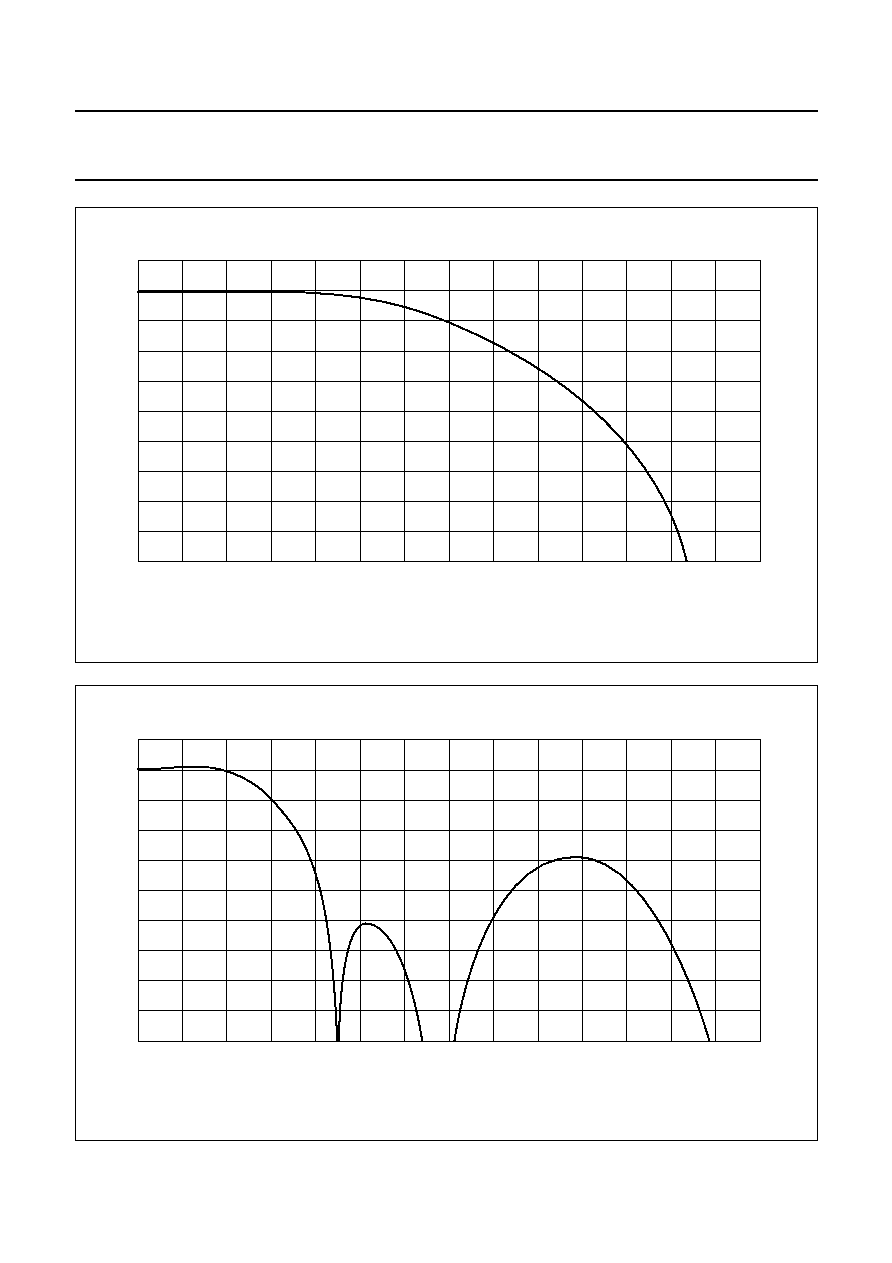
1999 May 31
26
Philips Semiconductors
Product specification
Digital video encoder
SAA7126H; SAA7127H
handbook, full pagewidth
6
8
10
12
14
6
0
0
2
4
MGB708
-
6
-
12
-
18
-
30
-
24
-
36
-
42
-
54
-
48
f (MHz)
Gv
(dB)
Fig.7 Luminance transfer characteristic in RGB.
handbook, full pagewidth
6
8
10
12
14
6
0
0
2
4
MGB706
-
6
-
12
-
18
-
30
-
24
-
36
-
42
-
54
-
48
f (MHz)
Gv
(dB)
Fig.8 Colour difference transfer characteristic in RGB.
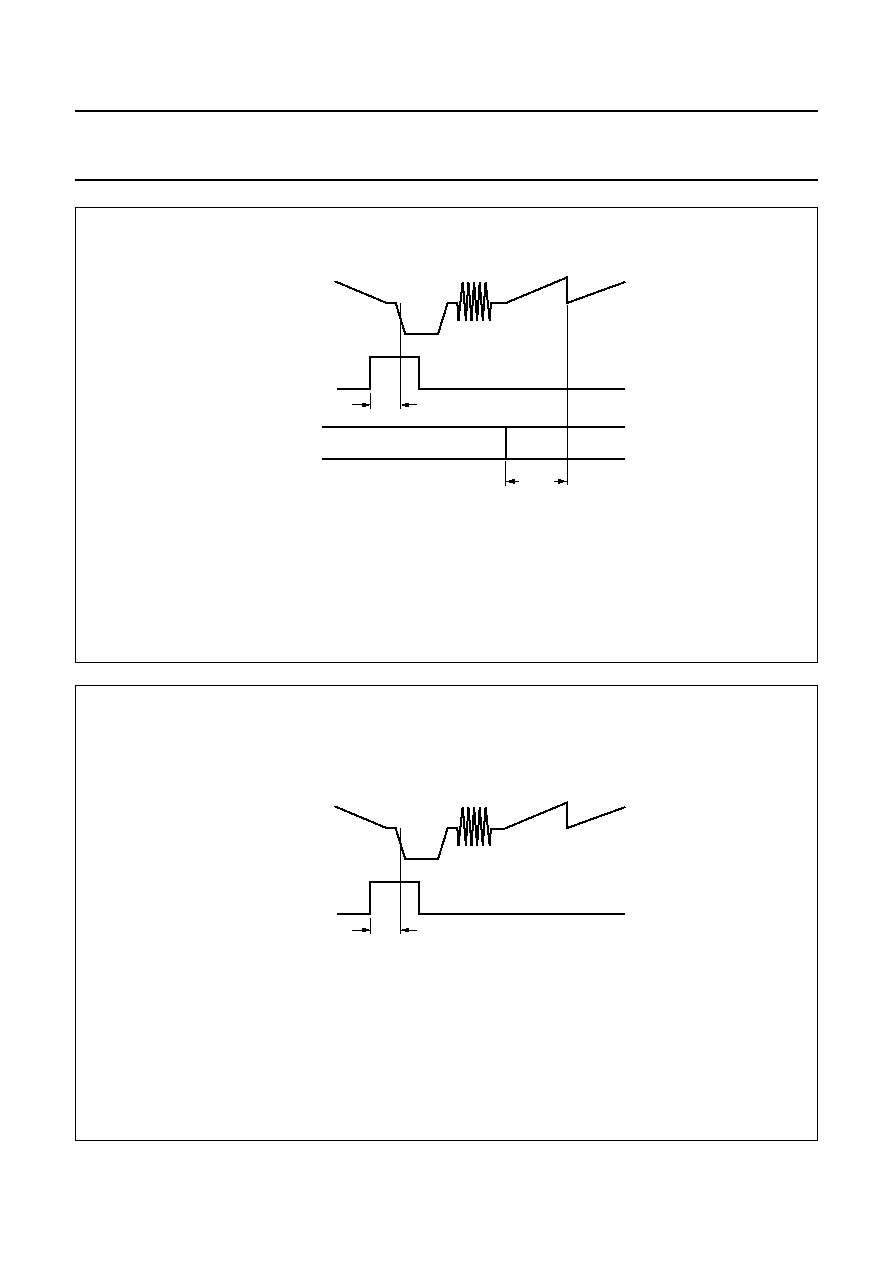
1999 May 31
27
Philips Semiconductors
Product specification
Digital video encoder
SAA7126H; SAA7127H
HTRIG = 0
PRCV2 = 0.
TRCV2 = 1.
ORCV2 = 0.
Fig.9 Sync and video input timing.
handbook, full pagewidth
MHB500
55LLC
51LLC
MP input
RCV2 input
CVBS output
RCV2S = 0.
PRCV2 = 0.
ORCV2 = 1.
Fig.10 Sync and video output timing.
handbook, full pagewidth
MHB501
49LLC
RCV2 output
CVBS output
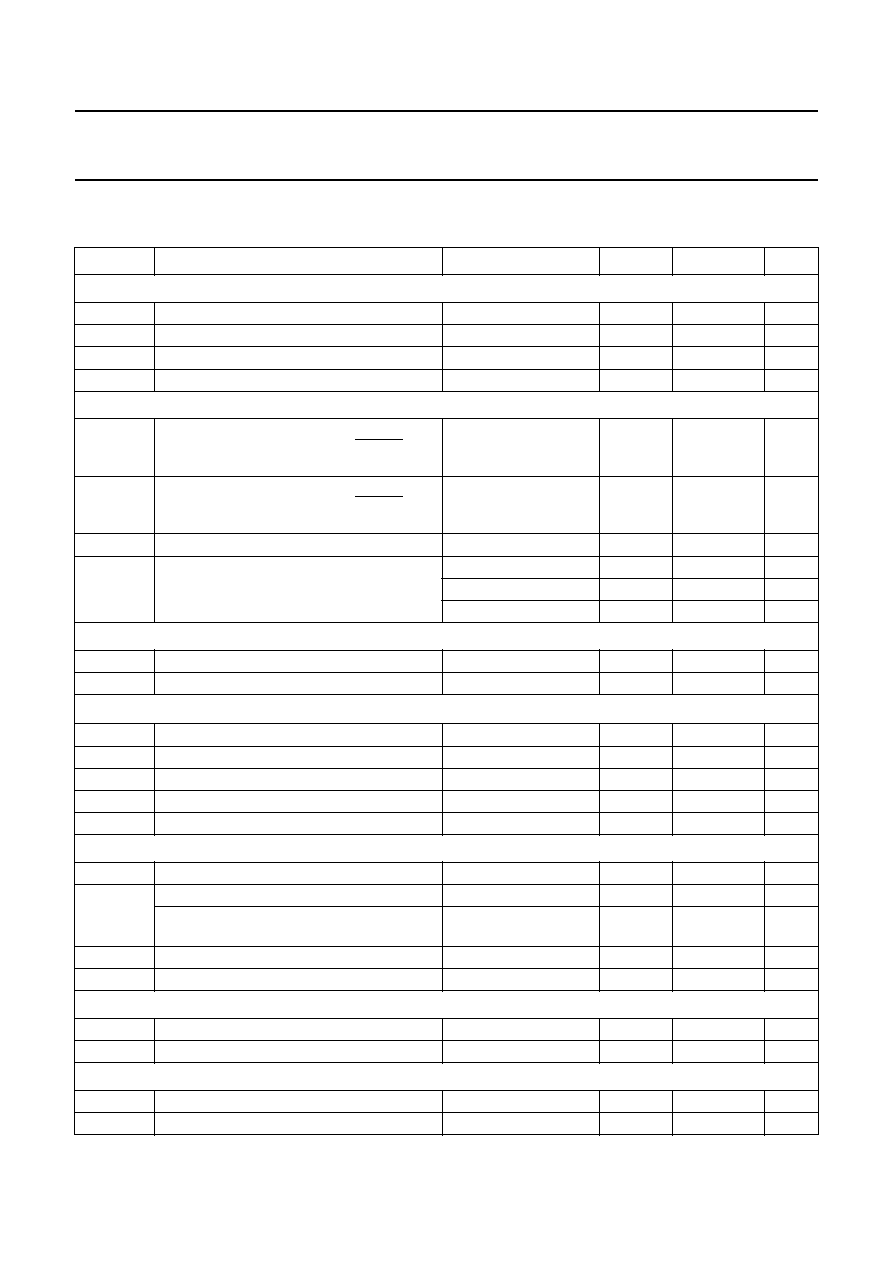
1999 May 31
28
Philips Semiconductors
Product specification
Digital video encoder
SAA7126H; SAA7127H
CHARACTERISTICS
V
DDD
= 3.0 to 3.6 V; T
amb
= 0 to 70
∞
C; unless otherwise specified.
SYMBOL
PARAMETER
CONDITIONS
MIN.
MAX.
UNIT
Supplies
V
DDA
analog supply voltage
3.15
3.45
V
V
DDD
digital supply voltage
3.0
3.6
V
I
DDA
analog supply current
note 1
-
100
mA
I
DDD
digital supply current
V
DDD
= 3.3 V; note 1
-
46
mA
Inputs
V
IL
LOW-level input voltage (pins LLC1, RCV1,
RCV2, MP7 to MP0, RTCI, SA, RESET
and TTX)
-
0.5
+0.8
V
V
IH
HIGH-level input voltage (pins LLC1, RCV1,
RCV2, MP7 to MP0, RTCI, SA, RESET
and TTX)
2.0
V
DDD
+ 0.3
V
I
LI
input leakage current
-
1
µ
A
C
i
input capacitance
clocks
-
10
pF
data
-
8
pF
I/Os at high-impedance
-
8
pF
Outputs; pins RCV1, RCV2 and TTXRQ
V
OL
LOW-level output voltage
I
OL
= 2 mA
-
0.4
V
V
OH
HIGH-level output voltage
I
OH
= 2 mA
2.4
-
V
I
2
C-bus; SDA and SCL
V
IL
LOW-level input voltage
-
0.5
0.3V
DD(I2C)
V
V
IH
HIGH-level input voltage
0.7V
DD(I2C)
V
DD(I2C)
+ 0.3 V
I
i
input current
V
i
= LOW or HIGH
-
10
+10
µ
A
V
OL
LOW-level output voltage (pin SDA)
I
OL
= 3 mA
-
0.4
V
I
o
output current
during acknowledge
3
-
mA
Clock timing (pins LLC1 and XCLK)
T
LLC1
cycle time
note 2
34
41
ns
duty factor t
HIGH
/T
LLC1
LLC1 input
40
60
%
duty factor t
HIGH
/T
XCLK
XCLK output typical
50%
40
60
%
t
r
rise time
note 2
-
5
ns
t
f
fall time
note 2
-
6
ns
Input timing; pins LLC1, RCV1, RCV2, MP7 to MP0, RTCI, SA and TTX
t
SU;DAT
input data set-up time
6
-
ns
t
HD;DAT
input data hold time
3
-
ns
Crystal oscillator
f
n
nominal frequency (usually 27 MHz)
3rd-harmonic
-
30
MHz
f/f
n
permissible deviation of nominal frequency
note 3
-
50
+50
10
-
6

1999 May 31
29
Philips Semiconductors
Product specification
Digital video encoder
SAA7126H; SAA7127H
Notes
1. At maximum supply voltage with highly active input signals.
2. The data is for both input and output direction.
3. If an internal oscillator is used, crystal deviation of nominal frequency is directly proportional to the deviation of
subcarrier frequency and line/field frequency.
4. For full digital range, without load, V
DDA
= 3.3 V. The typical voltage swing is 1.45 V, the typical minimum output
voltage (digital zero at DAC) is 0.2 V.
C
RYSTAL SPECIFICATION
T
amb
ambient temperature
0
70
∞
C
C
L
load capacitance
8
-
pF
R
S
series resistance
-
80
C
1
motional capacitance (typical)
1.5
-
20% 1.5 + 20%
fF
C
0
parallel capacitance (typical)
3.5
-
20% 3.5 + 20%
pF
Data and reference signal output timing
C
L
output load capacitance
7.5
40
pF
t
h
output hold time
4
-
ns
t
d
output delay time
-
25
ns
CVBS and RGB outputs
V
o(p-p)
output signal voltage (peak-to-peak value)
note 4
1.30
1.55
V
V
o
inequality of output signal voltages
-
2
%
R
s(int)
internal serial resistance
1
3
R
L
output load resistance
75
300
B
output signal bandwidth of DACs
-
3 dB
10
-
MHz
LE
lf(i)
low frequency integral linearity error of DACs
-
±
3
LSB
LE
lf(d)
low frequency differential linearity error of
DACs
-
±
1
LSB
t
d(pipe)(MP)
total pipeline delay from MP port
27 MHz
-
51
LLC
SYMBOL
PARAMETER
CONDITIONS
MIN.
MAX.
UNIT
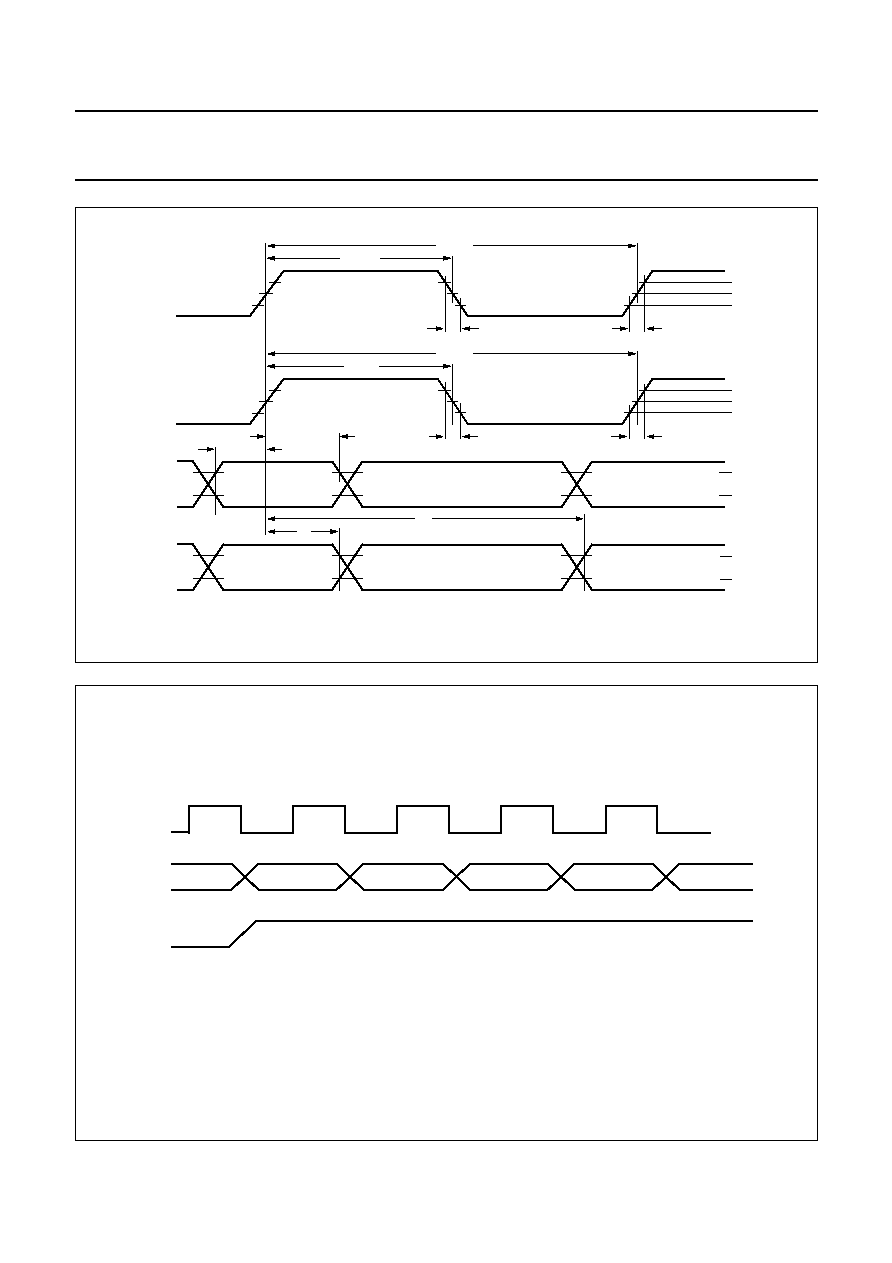
1999 May 31
30
Philips Semiconductors
Product specification
Digital video encoder
SAA7126H; SAA7127H
Fig.11 Clock data timing.
handbook, full pagewidth
MHB502
XCLK
0.6 V
1.5 V
2.6 V
2.0 V
0.8 V
2.4 V
0.6 V
input data
output data
not valid
valid
valid
not valid
valid
valid
LLC1
0.8 V
1.5 V
2.4 V
tHIGH
tHIGH
TLLC1
TLLC1
td
tHD; DAT
th
tSU; DAT
tf
tf
tr
tr
The data demultiplexing phase is coupled to the internal horizontal phase.
The phase of the RCV2 signal is programmed to tbf (tbf for 50 Hz) in this example in output mode (RCV2S).
handbook, full pagewidth
MP(n)
LLC
Cb(0)
Y(0)
Cr(0)
Y(1)
Cb(2)
RCV2
MGB699
Fig.12 Functional timing.
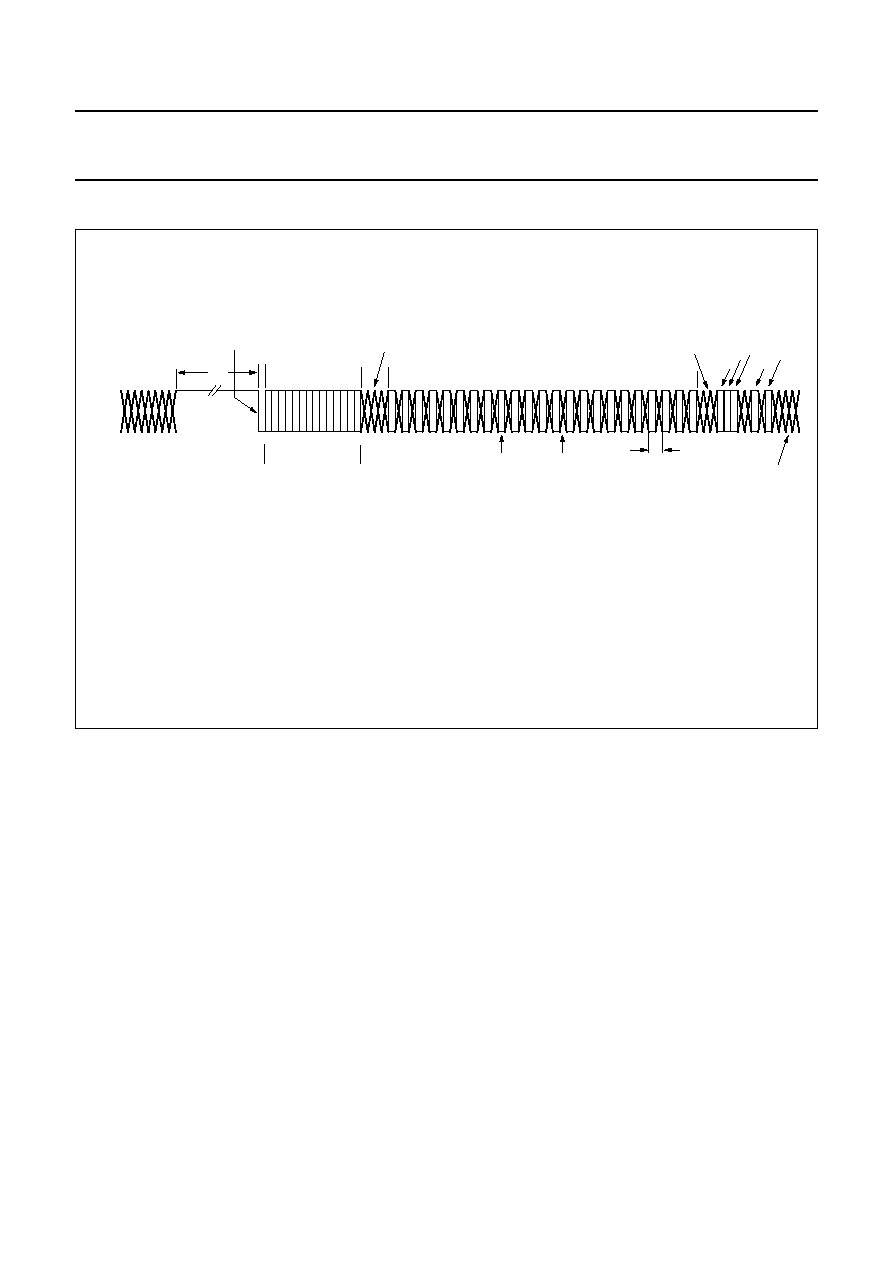
1999 May 31
31
Philips Semiconductors
Product specification
Digital video encoder
SAA7126H; SAA7127H
Explanation of RTCI data bits
1. The HPLL increment is not evaluated by SAA7126H; SAA7127H.
2. The SAA7126H; SAA7127H generates the subcarrier frequency from the FSCPLL increment if enabled (see item 7.).
3. The PAL bit indicates the line with inverted (R
-
Y) component of colour difference signal.
4. If the reset bit is enabled (RTCE = 1; DECPH = 1; PHRES = 00), the phase of the subcarrier is reset in each line
whenever the reset bit of RTCI input is set to logic 1.
5. If the FISE bit is enabled (RTCE = 1; DECFIS = 1), the SAA7126H; SAA7127H takes this bit instead of the FISE bit
in subaddress 61H.
6. If the odd/even bit is enabled (RTCE = 1; DECOE = 1), the SAA7126H; SAA7127H ignores it's internally generated
odd/even flag and takes the odd/even bit from RTCI input.
7. If the colour detection bit is enabled (RTCE = 1; DECCOL = 1) and no colour was detected (colour detection bit = 0),
the subcarrier frequency is generated by the SAA7126H; SAA7127H. In the other case (colour detection bit = 1) the
subcarrier frequency is evaluated out of FSCPLL increment.
If the colour detection bit is disabled (RTCE = 1; DECCOL = 0), the subcarrier frequency is evaluated out of FSCPLL
increment, independent of the colour detection bit of RTCI input.
Fig.13 RTCI timing.
(1) SAA7111/12 provides 14 to 0 bits, resulting in 2 reserved bits before FSCPLL increment.
(2) SAA7151 provides 21 to 0 bits only, resulting in 5 reserved bits before sequence bit.
(3) Sequence bit: PAL: 0 = (R
-
Y) line normal, 1 = (R
-
Y) line inverted; NTSC: 0 = no change.
(4) Reset bit: only from SAA7111 and SAA7112 decoder.
(5) FISE bit: 0 = 50 Hz, 1 = 60 Hz.
(6) Odd/even bit: odd_even from external.
(7) Colour detection: 0 = no colour detected, 1 = colour detected.
(8) Reserved bits: 229 with 50 Hz systems, 226 with 60 Hz systems.
handbook, full pagewidth
128
13
14
19
67
64
69 72 74
68
0 1
0
0
22
RTCI
HPLL
increment
(1)
FSCPLL increment
(2)
H/L transition
count start
4 bits
reserved
valid
sample
invalid
sample
not used in SAA7126H/27H
3 bits
reserved
8/LLC
MHB503
LOW
time slot:
(3)
(4)
(6)
(7)
(8)
(5)

1999 May 31
32
Philips Semiconductors
Product specification
Digital video encoder
SAA7126H; SAA7127H
Teletext timing
Time t
FD
is the time needed to interpolate input data TTX
and insert it into the CVBS and VBS output signal, such
that it appears at t
TTX
= 9.78
µ
s (PAL) or t
TTX
= 10.5
µ
s
(NTSC) after the leading edge of the horizontal
synchronization pulse.
Time t
d(pipe)(MP)
is the pipeline delay time introduced by the
source that is gated by TTXRQ in order to deliver TTX
data. This delay is programmable by register TTXHD. For
every active HIGH state at output pin TTXRQ, a new
teletext bit must be provided by the source (new protocol)
or a window of TTXRQ going HIGH is provided and the
number of teletext bits, depending on the chosen TTX
standard, is requested at input pin TTX (old protocol).
Since the beginning of the pulses representing the TTXRQ
signal and the delay between the rising edge of TTXRQ
and valid teletext input data are fully programmable
(TTXHS and TTXHD), the TTX data is always inserted at
the correct position after the leading edge of outgoing
horizontal synchronization pulse.
Time t
i(TTXW)
is the internally used insertion window for
TTX data; it has a constant length that allows insertion of
360 teletext bits at a text data rate of 6.9375 Mbits/s
(PAL), 296 teletext bits at a text data rate of 5.7272 Mbits/s
(world standard TTX) or 288 teletext bits at a text data rate
of 5.7272 Mbits/s (NABTS). The insertion window is not
opened if the control bit TTXEN is zero.
Using appropriate programming, all suitable lines of the
odd field (TTXOVS and TTXOVE) plus all suitable lines of
the even field (TTXEVS and TTXEVE) can be used for
teletext insertion.
Fig.14 Teletext timing.
handbook, full pagewidth
ti(TTXW)
tTTX
tPD
tFD
CVBS/Y
TTX
TTXRQ (new)
TTXRQ (old)
text bit #:
1
2
3
4
5
6
7
8
9
10 11
12
13
14
15
16
17
18 19 20
21
22
23
24
MHB504

1999
May
31
33
Philips Semiconductors
Product specification
Digital video encoder
SAA7126H; SAA7127H
This text is here in white to force landscape pages to be rotated correctly when browsing through the pdf in the Acrobat reader.This text is here in
_
white to force landscape pages to be rotated correctly when browsing through the pdf in the Acrobat reader.This text is here inThis text is here in
white to force landscape pages to be rotated correctly when browsing through the pdf in the Acrobat reader. white to force landscape pages to be ...
APPLICA
TION INFORMA
TION
o
ok, full pagewidth
2
(1)
23
75
AGND
23
RED
DAC1
DAC2
DAC3
UR
0.70 V (p-p)
(2)
23
75
AGND
GREEN
UG
0.70 V (p-p)
(2)
MHB505
23
75
AGND
AGND
DGND
BLUE
UB
0.70 V (p-p)
(2)
AGND
22, 32, 33
5, 18, 38
VDDA1 to VDDA3
+
3.3 V analog
+
3.3 V digital
VSSD1 to VSSD3
VDDD1 to VDDD3
VSSA1 to VSSA3
25, 28, 31
36
6, 17, 39
35
34
XTALI
XTAL
10 pF
10 pF
X1
use one capacitor
for each VDDD
use one capacitor
for each VDDA
2
(1)
26
VDDA4
2
(1)
29
DAC4
4.7
75
AGND
CVBS
UCVBS
1.23 V (p-p)
(2)
2
(1)
30
0.1
µ
F
AGND
0.1
µ
F
DGND
DGND
0.1
µ
F
0.1
µ
H
1 nF
3rd harmonic
27.0 MHz
digital
inputs and
outputs
SAA7126H
SAA7127H
Fig.15 Application circuit.
(1) Typical value.
(2) For
100
/
100
colour bar.

1999 May 31
34
Philips Semiconductors
Product specification
Digital video encoder
SAA7126H; SAA7127H
Analog output voltages
The analog output voltages are dependent on the open-loop voltage of the operational amplifiers for full-scale conversion
(typical value 1.375 V), the internal series resistor (typical value 2
), the external series resistor and the external load
impedance.
The digital output signals in front of the DACs under nominal conditions occupy different conversion ranges, as indicated
in Table 48 for a
100
/
100
colour bar signal.
Values for the external series resistors result in a 75
load.
Table 48 Digital output signals conversion range
CONVERSION RANGE (peak-to-peak)
CVBS, SYNC
TIP-TO-PEAK CARRIER
(digits)
Y (VBS)
SYNC TIP-TO-WHITE
(digits)
RGB (Y)
BLACK-TO-WHITE AT GDY = GDC =
-
6
(digits)
1016
881
712
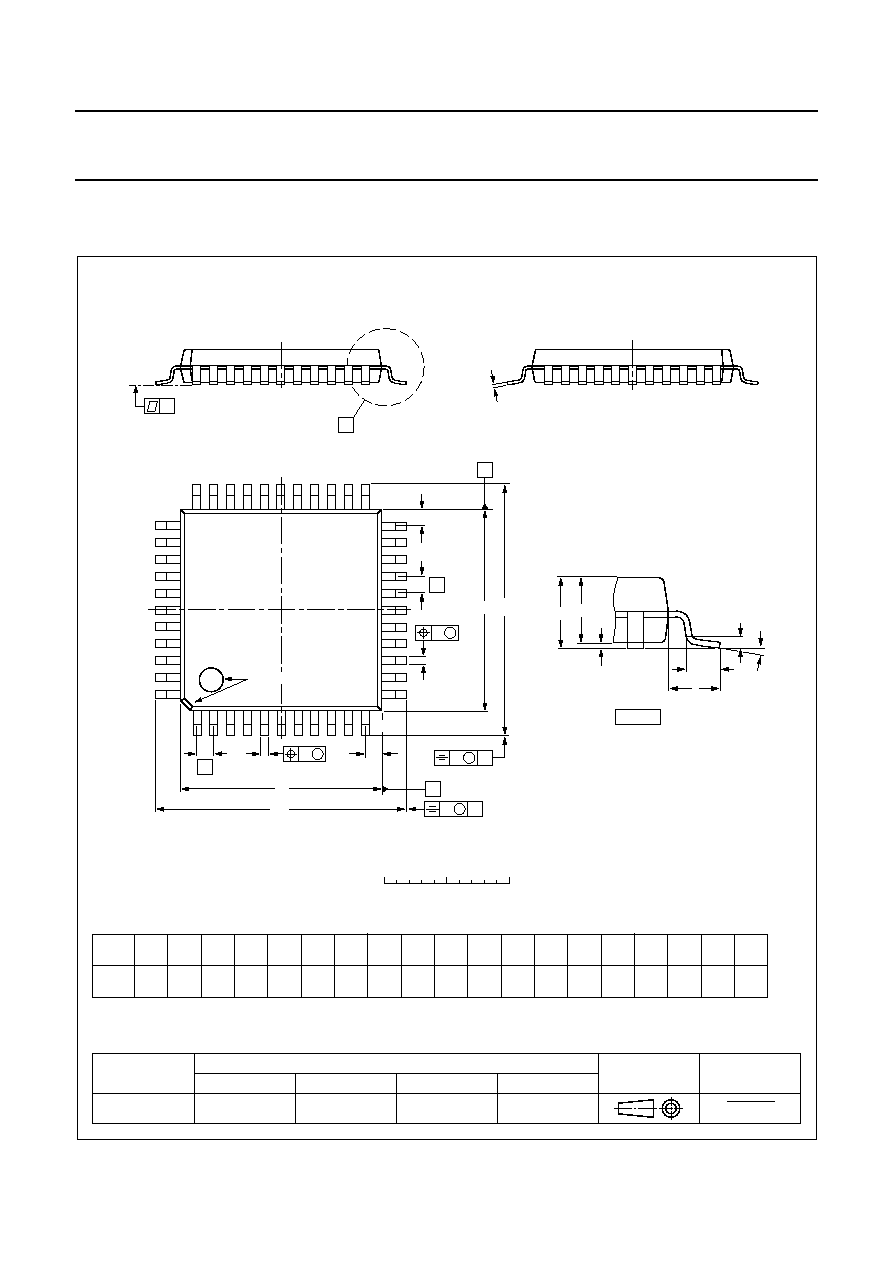
1999 May 31
35
Philips Semiconductors
Product specification
Digital video encoder
SAA7126H; SAA7127H
PACKAGE OUTLINE
UNIT
A
1
A
2
A
3
b
p
c
E
(1)
e
H
E
L
L
p
Z
y
w
v
REFERENCES
OUTLINE
VERSION
EUROPEAN
PROJECTION
ISSUE DATE
IEC
JEDEC
EIAJ
mm
0.25
0.05
1.85
1.65
0.25
0.40
0.20
0.25
0.14
10.1
9.9
0.8
1.3
12.9
12.3
1.2
0.8
10
0
o
o
0.15
0.1
0.15
DIMENSIONS (mm are the original dimensions)
Note
1. Plastic or metal protrusions of 0.25 mm maximum per side are not included.
0.95
0.55
SOT307-2
95-02-04
97-08-01
D
(1)
(1)
(1)
10.1
9.9
H
D
12.9
12.3
E
Z
1.2
0.8
D
e
E
B
11
c
E
H
D
ZD
A
Z E
e
v
M
A
X
1
44
34
33
23
22
12
y
A
1
A
L
p
detail X
L
(A )
3
A
2
pin 1 index
D
H
v
M
B
b
p
b
p
w
M
w
M
0
2.5
5 mm
scale
QFP44: plastic quad flat package; 44 leads (lead length 1.3 mm); body 10 x 10 x 1.75 mm
SOT307-2
A
max.
2.10

1999 May 31
36
Philips Semiconductors
Product specification
Digital video encoder
SAA7126H; SAA7127H
SOLDERING
Introduction to soldering surface mount packages
This text gives a very brief insight to a complex technology.
A more in-depth account of soldering ICs can be found in
our
"Data Handbook IC26; Integrated Circuit Packages"
(document order number 9398 652 90011).
There is no soldering method that is ideal for all surface
mount IC packages. Wave soldering is not always suitable
for surface mount ICs, or for printed-circuit boards with
high population densities. In these situations reflow
soldering is often used.
Reflow soldering
Reflow soldering requires solder paste (a suspension of
fine solder particles, flux and binding agent) to be applied
to the printed-circuit board by screen printing, stencilling or
pressure-syringe dispensing before package placement.
Several methods exist for reflowing; for example,
infrared/convection heating in a conveyor type oven.
Throughput times (preheating, soldering and cooling) vary
between 100 and 200 seconds depending on heating
method.
Typical reflow peak temperatures range from
215 to 250
∞
C. The top-surface temperature of the
packages should preferable be kept below 230
∞
C.
Wave soldering
Conventional single wave soldering is not recommended
for surface mount devices (SMDs) or printed-circuit boards
with a high component density, as solder bridging and
non-wetting can present major problems.
To overcome these problems the double-wave soldering
method was specifically developed.
If wave soldering is used the following conditions must be
observed for optimal results:
∑
Use a double-wave soldering method comprising a
turbulent wave with high upward pressure followed by a
smooth laminar wave.
∑
For packages with leads on two sides and a pitch (e):
≠ larger than or equal to 1.27 mm, the footprint
longitudinal axis is preferred to be parallel to the
transport direction of the printed-circuit board;
≠ smaller than 1.27 mm, the footprint longitudinal axis
must be parallel to the transport direction of the
printed-circuit board.
The footprint must incorporate solder thieves at the
downstream end.
∑
For packages with leads on four sides, the footprint must
be placed at a 45
∞
angle to the transport direction of the
printed-circuit board. The footprint must incorporate
solder thieves downstream and at the side corners.
During placement and before soldering, the package must
be fixed with a droplet of adhesive. The adhesive can be
applied by screen printing, pin transfer or syringe
dispensing. The package can be soldered after the
adhesive is cured.
Typical dwell time is 4 seconds at 250
∞
C.
A mildly-activated flux will eliminate the need for removal
of corrosive residues in most applications.
Manual soldering
Fix the component by first soldering two
diagonally-opposite end leads. Use a low voltage (24 V or
less) soldering iron applied to the flat part of the lead.
Contact time must be limited to 10 seconds at up to
300
∞
C.
When using a dedicated tool, all other leads can be
soldered in one operation within 2 to 5 seconds between
270 and 320
∞
C.

1999 May 31
37
Philips Semiconductors
Product specification
Digital video encoder
SAA7126H; SAA7127H
Suitability of surface mount IC packages for wave and reflow soldering methods
Notes
1. All surface mount (SMD) packages are moisture sensitive. Depending upon the moisture content, the maximum
temperature (with respect to time) and body size of the package, there is a risk that internal or external package
cracks may occur due to vaporization of the moisture in them (the so called popcorn effect). For details, refer to the
Drypack information in the
"Data Handbook IC26; Integrated Circuit Packages; Section: Packing Methods".
2. These packages are not suitable for wave soldering as a solder joint between the printed-circuit board and heatsink
(at bottom version) can not be achieved, and as solder may stick to the heatsink (on top version).
3. If wave soldering is considered, then the package must be placed at a 45
∞
angle to the solder wave direction.
The package footprint must incorporate solder thieves downstream and at the side corners.
4. Wave soldering is only suitable for LQFP, TQFP and QFP packages with a pitch (e) equal to or larger than 0.8 mm;
it is definitely not suitable for packages with a pitch (e) equal to or smaller than 0.65 mm.
5. Wave soldering is only suitable for SSOP and TSSOP packages with a pitch (e) equal to or larger than 0.65 mm; it is
definitely not suitable for packages with a pitch (e) equal to or smaller than 0.5 mm.
PACKAGE
SOLDERING METHOD
WAVE
REFLOW
(1)
BGA, SQFP
not suitable
suitable
HLQFP, HSQFP, HSOP, HTSSOP, SMS not suitable
(2)
suitable
PLCC
(3)
, SO, SOJ
suitable
suitable
LQFP, QFP, TQFP
not recommended
(3)(4)
suitable
SSOP, TSSOP, VSO
not recommended
(5)
suitable

1999 May 31
38
Philips Semiconductors
Product specification
Digital video encoder
SAA7126H; SAA7127H
DEFINITIONS
LIFE SUPPORT APPLICATIONS
These products are not designed for use in life support appliances, devices, or systems where malfunction of these
products can reasonably be expected to result in personal injury. Philips customers using or selling these products for
use in such applications do so at their own risk and agree to fully indemnify Philips for any damages resulting from such
improper use or sale.
PURCHASE OF PHILIPS I
2
C COMPONENTS
Data sheet status
Objective specification
This data sheet contains target or goal specifications for product development.
Preliminary specification
This data sheet contains preliminary data; supplementary data may be published later.
Product specification
This data sheet contains final product specifications.
Limiting values
Limiting values given are in accordance with the Absolute Maximum Rating System (IEC 134). Stress above one or
more of the limiting values may cause permanent damage to the device. These are stress ratings only and operation
of the device at these or at any other conditions above those given in the Characteristics sections of the specification
is not implied. Exposure to limiting values for extended periods may affect device reliability.
Application information
Where application information is given, it is advisory and does not form part of the specification.
Purchase of Philips I
2
C components conveys a license under the Philips' I
2
C patent to use the
components in the I
2
C system provided the system conforms to the I
2
C specification defined by
Philips. This specification can be ordered using the code 9398 393 40011.

1999 May 31
39
Philips Semiconductors
Product specification
Digital video encoder
SAA7126H; SAA7127H
NOTES

© Philips Electronics N.V.
SCA
All rights are reserved. Reproduction in whole or in part is prohibited without the prior written consent of the copyright owner.
The information presented in this document does not form part of any quotation or contract, is believed to be accurate and reliable and may be changed
without notice. No liability will be accepted by the publisher for any consequence of its use. Publication thereof does not convey nor imply any license
under patent- or other industrial or intellectual property rights.
Internet: http://www.semiconductors.philips.com
1999
65
Philips Semiconductors ≠ a worldwide company
Netherlands: Postbus 90050, 5600 PB EINDHOVEN, Bldg. VB,
Tel. +31 40 27 82785, Fax. +31 40 27 88399
New Zealand: 2 Wagener Place, C.P.O. Box 1041, AUCKLAND,
Tel. +64 9 849 4160, Fax. +64 9 849 7811
Norway: Box 1, Manglerud 0612, OSLO,
Tel. +47 22 74 8000, Fax. +47 22 74 8341
Pakistan: see Singapore
Philippines: Philips Semiconductors Philippines Inc.,
106 Valero St. Salcedo Village, P.O. Box 2108 MCC, MAKATI,
Metro MANILA, Tel. +63 2 816 6380, Fax. +63 2 817 3474
Poland: Ul. Lukiska 10, PL 04-123 WARSZAWA,
Tel. +48 22 612 2831, Fax. +48 22 612 2327
Portugal: see Spain
Romania: see Italy
Russia: Philips Russia, Ul. Usatcheva 35A, 119048 MOSCOW,
Tel. +7 095 755 6918, Fax. +7 095 755 6919
Singapore: Lorong 1, Toa Payoh, SINGAPORE 319762,
Tel. +65 350 2538, Fax. +65 251 6500
Slovakia: see Austria
Slovenia: see Italy
South Africa: S.A. PHILIPS Pty Ltd., 195-215 Main Road Martindale,
2092 JOHANNESBURG, P.O. Box 58088 Newville 2114,
Tel. +27 11 471 5401, Fax. +27 11 471 5398
South America: Al. Vicente Pinzon, 173, 6th floor,
04547-130 S√O PAULO, SP, Brazil,
Tel. +55 11 821 2333, Fax. +55 11 821 2382
Spain: Balmes 22, 08007 BARCELONA,
Tel. +34 93 301 6312, Fax. +34 93 301 4107
Sweden: Kottbygatan 7, Akalla, S-16485 STOCKHOLM,
Tel. +46 8 5985 2000, Fax. +46 8 5985 2745
Switzerland: Allmendstrasse 140, CH-8027 ZÐRICH,
Tel. +41 1 488 2741 Fax. +41 1 488 3263
Taiwan: Philips Semiconductors, 6F, No. 96, Chien Kuo N. Rd., Sec. 1,
TAIPEI, Taiwan Tel. +886 2 2134 2886, Fax. +886 2 2134 2874
Thailand: PHILIPS ELECTRONICS (THAILAND) Ltd.,
209/2 Sanpavuth-Bangna Road Prakanong, BANGKOK 10260,
Tel. +66 2 745 4090, Fax. +66 2 398 0793
Turkey: Yukari Dudullu, Org. San. Blg., 2.Cad. Nr. 28 81260 Umraniye,
ISTANBUL, Tel. +90 216 522 1500, Fax. +90 216 522 1813
Ukraine: PHILIPS UKRAINE, 4 Patrice Lumumba str., Building B, Floor 7,
252042 KIEV, Tel. +380 44 264 2776, Fax. +380 44 268 0461
United Kingdom: Philips Semiconductors Ltd., 276 Bath Road, Hayes,
MIDDLESEX UB3 5BX, Tel. +44 181 730 5000, Fax. +44 181 754 8421
United States: 811 East Arques Avenue, SUNNYVALE, CA 94088-3409,
Tel. +1 800 234 7381, Fax. +1 800 943 0087
Uruguay: see South America
Vietnam: see Singapore
Yugoslavia: PHILIPS, Trg N. Pasica 5/v, 11000 BEOGRAD,
Tel. +381 11 62 5344, Fax.+381 11 63 5777
For all other countries apply to: Philips Semiconductors,
International Marketing & Sales Communications, Building BE-p, P.O. Box 218,
5600 MD EINDHOVEN, The Netherlands, Fax. +31 40 27 24825
Argentina: see South America
Australia: 34 Waterloo Road, NORTH RYDE, NSW 2113,
Tel. +61 2 9805 4455, Fax. +61 2 9805 4466
Austria: Computerstr. 6, A-1101 WIEN, P.O. Box 213,
Tel. +43 1 60 101 1248, Fax. +43 1 60 101 1210
Belarus: Hotel Minsk Business Center, Bld. 3, r. 1211, Volodarski Str. 6,
220050 MINSK, Tel. +375 172 20 0733, Fax. +375 172 20 0773
Belgium: see The Netherlands
Brazil: see South America
Bulgaria: Philips Bulgaria Ltd., Energoproject, 15th floor,
51 James Bourchier Blvd., 1407 SOFIA,
Tel. +359 2 68 9211, Fax. +359 2 68 9102
Canada: PHILIPS SEMICONDUCTORS/COMPONENTS,
Tel. +1 800 234 7381, Fax. +1 800 943 0087
China/Hong Kong: 501 Hong Kong Industrial Technology Centre,
72 Tat Chee Avenue, Kowloon Tong, HONG KONG,
Tel. +852 2319 7888, Fax. +852 2319 7700
Colombia: see South America
Czech Republic: see Austria
Denmark: Sydhavnsgade 23, 1780 COPENHAGEN V,
Tel. +45 33 29 3333, Fax. +45 33 29 3905
Finland: Sinikalliontie 3, FIN-02630 ESPOO,
Tel. +358 9 615 800, Fax. +358 9 6158 0920
France: 51 Rue Carnot, BP317, 92156 SURESNES Cedex,
Tel. +33 1 4099 6161, Fax. +33 1 4099 6427
Germany: Hammerbrookstraþe 69, D-20097 HAMBURG,
Tel. +49 40 2353 60, Fax. +49 40 2353 6300
Hungary: see Austria
India: Philips INDIA Ltd, Band Box Building, 2nd floor,
254-D, Dr. Annie Besant Road, Worli, MUMBAI 400 025,
Tel. +91 22 493 8541, Fax. +91 22 493 0966
Indonesia: PT Philips Development Corporation, Semiconductors Division,
Gedung Philips, Jl. Buncit Raya Kav.99-100, JAKARTA 12510,
Tel. +62 21 794 0040 ext. 2501, Fax. +62 21 794 0080
Ireland: Newstead, Clonskeagh, DUBLIN 14,
Tel. +353 1 7640 000, Fax. +353 1 7640 200
Israel: RAPAC Electronics, 7 Kehilat Saloniki St, PO Box 18053,
TEL AVIV 61180, Tel. +972 3 645 0444, Fax. +972 3 649 1007
Italy: PHILIPS SEMICONDUCTORS, Piazza IV Novembre 3,
20124 MILANO, Tel. +39 02 67 52 2531, Fax. +39 02 67 52 2557
Japan: Philips Bldg 13-37, Kohnan 2-chome, Minato-ku,
TOKYO 108-8507, Tel. +81 3 3740 5130, Fax. +81 3 3740 5057
Korea: Philips House, 260-199 Itaewon-dong, Yongsan-ku, SEOUL,
Tel. +82 2 709 1412, Fax. +82 2 709 1415
Malaysia: No. 76 Jalan Universiti, 46200 PETALING JAYA, SELANGOR,
Tel. +60 3 750 5214, Fax. +60 3 757 4880
Mexico: 5900 Gateway East, Suite 200, EL PASO, TEXAS 79905,
Tel. +9-5 800 234 7381, Fax +9-5 800 943 0087
Middle East: see Italy
Printed in The Netherlands
545006/01/pp40
Date of release: 1999 May 31
Document order number:
9397 750 05278







































